- Hummingbird Blog
- Feeder Choices
- Nectar Recipe
- Privacy Policy
- Tray Feeders
- Basic Feeders
- Decorative Feeders
- Unique Feeders
- Window Feeders
- Accessories/Parts
- BirdCams/Nest Boxes
- Wind Chimes
- Testimonials
- Ship & Returns
- Photography
- Your Hummer Stories
- Hummingbird Cake
- Our New Travel Site
FTC Disclosure: If you make a purchase via a link on this site, We may receive a small commission on the transaction - at no added cost to you. Thank you!

Hummingbird Travel
Hummingbird travel can be fun and interesting.
Where are the best places to see hummingbirds?
In our research about hummingbirds, we were made aware of the wealth of travel opportunities for the hummingbird enthusiast.
We are really happy to begin sharing these with you.
Whether you are looking for a romantic getaway, an exciting adventure, or a simple family outing, there many related to the hummingbird.
The most obvious place for most of us to see hummingbirds is our own backyards. We don't need to travel very far and all anyone needs to do is learn about attracting hummingbirds.
However, hummingbirds are migratory and so many of us suffer from hummingbird deprivation during the winter months. We can travel to Arizona or California because these states host hummingbirds year round.
Arizona is a hotspot and definitely the place to go. Arizona has 11 species of hummingbirds, more than any other state in the U.S.
In this country, when you consider time of year and weather conditions, there are parks in various states where you can see hummingbirds in the wild. These parks encourage visitors to sit and watch for the birds by providing benches.
Some even have field guides for hikers. If you are a hiker, the hummingbird to see is the Broad-tailed hummingbird or commonly named the Mountain hummingbird. We even know of people who bring there hummingbird feeders along on a hike to get a close-up view of these spectacular hummingbirds.
Hummingbird Travel Categories and Links:
- Aviaries - Hummingbirds do not live well in captivity. This is why only a few aviaries have hummingbirds at all. The few that do are large enough to allow for the territorial birds to live comfortably without stress.They also have an eco-system that duplicates their environment in the wild. These aviaries fit the bill..no pun intended!
Arizona-Sonora Desert Museum San Diego Zoo Cameron Zoological Park Butterfly World Park
- Museums -with exhibits dedicated to hummingbirds
Vermont Fairbanks Museum Museums with Hummingbird Specimen Exhibits
- Art exhibits -containing hummingbird art. The most famous hummingbird artists are James Audubon, John Gould and Frieda Khalo. You can find current art exhibitions of their work.
- Hummingbird Festivals -fun outings often with banding demonstrations, "Adopt-A-Hummingbird", and many activities for children and adults alike
See the current schedule of Hummingbird Festivals
- Gardens -both public and private, often with tours of specific flowers preferred by hummingbirds. Some have lovely fountains, misters, and bird baths enjoyed by hummingbirds
We recommend Ramsey Canyon Preserve in Hereford Arizona.
One of the famous hummingbird gardens is Marion Paton's Birders Haven Hummingbird Garden.
Marion and Wally Paton lived on a hummingbird migration route.
So they kept their feeders full for 15 species of hummingbirds that passed through during their migration journey.
Even though the Patons have passed, local birders continue to fill the feeders for the countless hummingbirds who travel here.
We think of this location as an almost sacred tribute to the hummingbirds.
Ramsey Canyon Preserve Paton Hummingbird Garden
- Inns - named for the hummingbird, many with gardens, feeders, and many hummingbirds.
- Bed and Breakfasts - offering a greater chance to meet other hummingbird enthusiasts.
- Parks - in the United States, Mexico, Costa Rica, and South America with hiking areas and family nature parks to view hummingbirds. Arza-Borrego Dessert Park in San Diego County, California is the largest state park in California. This park has dozens of hiking trails with views of wild flowers and birds including hummingbirds. The Living Dessert and Zoo in Palm Springs, California -here in August you might see hundreds of Anna's and Costa's Madera Canyon Park, Green Valley Arizona is a hummingbird aficionado's dream. When you visit this park, you will see a lot of hummingbirds in their most natural environment. In particular, take the Agua Caliente Trail to find hummingbirds. Davis Mountain State Park, Fort Davis, Texas has a remarkable 15 species of hummingbirds.If you enjoy camping, this park is great for you.
The Living Desert Zoo Madera Canyon Park Davis Mountains State Park
- Resorts -romantic travel with first class accommodations containing hummingbird gardens for the romantic couple. The Tingalayas Retreat The Hummingbird Beach Resort
- Eco-Lodges - for adventurers who favor eco-friendly lodging with hiking tours and viewing opportunities of exotic species.
Tranquility Lodge
- Photography Tours -in the Unites States, Costa Rica, and South America where it is possible to learn the professional techniques of hummingbird picture taking.
Do you enjoy travel with a spouse, family members, friends or alone?
There are even websites that connect birding travel buddies..... "Find a birder to go birdwatching with anywhere in the world" at Birdingpal .org .
Check back to this page often. We will continue to add new hummingbird travel opportunities as we discover them.
Happy Travel Days to You!
New! Comments
Find Us Here!
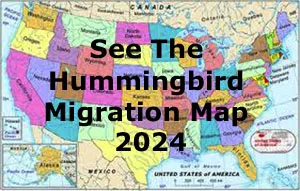
Stay in Touch with the Latest!
Subscribe to the "Hummer" Newsletter.
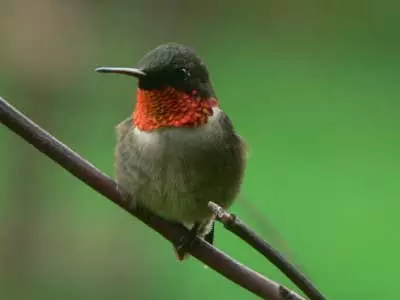
FTC Disclosure: If you make a purchase via a link on this site, We may receive a small commission on the transaction - at no added cost to you. Thank you!
Hummingbird Festivals 2024. Plus Banding Events, Exhibits, Workshops.
Apr 28, 24 11:43 AM
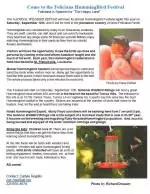
Hummingbird Migration Map 2024. Updated Hourly With Your Sightings.
Apr 24, 24 11:00 AM
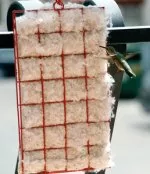
Senior Travel Resources - From Our Other Site - Senior Travel Central

Subscribe to "The Hummer" FREE Newsletter
Sign-up and receive a 10% discount on your entire order in our store.
We promise to only use your email for our Newsletter.
We will absolutely NOT share your email with anyone.
By James White , Copyright © 2009-2024 Hummingbird-guide.com ™ All Rights Reserved
Ver sitio en español
.png)
LAZULINE SABREWING PHOTOGRAPHED IN COLOMBIA
Carole turek is on a relentless pursuit to photograph every hummingbird species, join her in her travels:, subscribe to her, youtube channel here, instagram: hummingbirdspot, join the facebook group "hummingbird spot", links to her trip reports with pictures and videos are below, we have something here for every hummingbird lover.

Blue-bearded Helmetcrest
World's rarest hummingbird, photographed february, 2020, trip reports, 24/7 live cam in studio city, california, welcome to hummingbird spot , let us introduce ourselves.

Carole Turek
Chief Hummingbird Spotter
Hummingbird Photographer
The Studio City Gang Caretaker
Assistant to Fillmore

The Resident Bird Expert
Lover of Hummingbirds
Part-time Comedian and Model
Carole's Boss

The Studio City Gang
Black-Chinned, Anna's, Allen's, Costa's Hummingbirds
and more visit Carole's home daily!
CHECK THE WEBCAM
Let's take a tour!
I'd love to show you the site, something for the newbie, seasoned and expert hummingbird lover.

Discover Hummingbirds
If you are just getting to know hummingbirds, this is a great section to get started. Here you get to know all the best fun facts and basic knowledge about hummingbirds!

After you've learned the basics about hummingbirds, it's time to dive in deep and really get to know these amazing birds on an intimate level.

We're Live!
Things are about to get exciting for hummingbird lovers all over the world! We have our award winning live stream camera broadcasting hummingbirds 24 hours a day, 365 days year. Our camera is based in Studio City, California, USA and is a dream come true for bird lovers everywhere.
But we are not done yet! Our chief Hummingbird Spotter, Carole Turek, is traveling the America's to photograph and video many species of hummingbirds in their native environments. Our members will get to enjoy these hummingbird photography trips virtually and witness the beauty of the hummingbirds from Alaska down to the southern tips of South America.
All of this is exclusive to Hummingbird Spot! This is the closest to the hummingbird you can get virtually!

Hand's On with Hummingbirds and Our Community
Now that you've learned everything about hummingbirds and you've starting to watch them fly around, eat, mate and maybe even fight, it's time to get involved! This section is filled with all kinds of How To's and DIY projects. Learn to create your own backyard hummingbird restaurant, spa and nesting depot!
If you are interested in photographing hummingbirds, or you already do, we have great tips for achieving the best pictures! Not sure what to do with the pictures you take? We are always looking for amateur hummingbird photographers to contribute to our site. You may even earn some extra cash if your pictures sell in our gallery or gift shop!
Last but not least, this is where you learn about becoming an official Hummingbird Spotter by joining our community! Nothing beats having friends with similar interests! We gather and share through our private Facebook group everyday! Don't miss out - Join the Facebook Group "Hummingbird Spot."

Got Kids? Hummingbird Spot for Kids!
Every parent in today's modern world is looking for ways to get there kids off technology and out into nature. Getting involved with hummingbirds is a great hobby for kids and full of enrichment benefits! Visit this section for kid friendly learning, DIY projects, live camera streaming and even a community of other kids that love these birds.

The Gallery and Print Shop
Here we featured all the original photography of our Chief Hummingbird Spotter, Carole Turek. As well, we feature photography from our community friends that have become official Hummingbird Spot contributing photographers. If you love birds, you will love this amazing gallery!
If you find an image you just can't stop staring at, our prints can be purchased through our print shop or even custom printed on a variety of gift products.

nothing but
Benefits and fun, don't miss out, become a hummingbird spotter now.
Fun and Interesting Learning
Award Winning Live Streaming Cams
Live Events
Community of friends
Virtual Hummingbird Travel Vacations
How to Open a Hummingbird Restaurant
How to Open a Hummingbird Spa
DIY Projects
Hummingbirds Improve your Health
Original Hummingbird Photo Gallery
Photography Opportunities
Enrichment for kids
"I can't wait to meet you! H'oredeves are waiting!"
- Fillmore The Resident Bird Expert for Hummingbird Spot

- International edition
- Australia edition
- Europe edition

'An ashram for the hummingbird': the Trinidad haven for world's tiniest bird
Theo and Gloria Ferguson have created a garden specially designed to attract hummingbirds – and hundreds visit daily
A t the foot of Theo and Gloria Ferguson’s property stands a giant silk cotton tree. Reminiscent of those enchanted species in children’s fables, this ancient sentinel’s huge varicose limbs yawn upwards and outwards, towards a canopy of leaves that scratch the sky. Eight adults linking arms would struggle to encircle its vast girth, proof of the aeons it has stood guarding the edge of Trinidad’s Maracas valley.

It could be that this tree was a mere sapling when the indigenous people who first lived here named this land Iere , or “Land of the Hummingbird”. So bewitched were they by these bejewelled creatures that they created a myth to protect the birds, which they believed represented the souls of their dead. According to the legend, the La Brea Pitch Lake – a sprawling bitumen wonder in the south-west of Trinidad, now a Unesco world heritage site – was once the home of the Chima Indians. However, the tribe induced the wrath of the gods by dining on hummingbirds at a celebratory feast. In their fury, the gods opened up the earth and summoned the sulphurous lake of pitch to consume the village and its people.
The Amerindians and their myths could not protect the hummingbird for ever. The birds’ population and that of its human defenders was nearly decimated when the first European settlers arrived on the islands 500 years ago. The hummingbird’s striking plumage, exemplified by names such as ruby-throated, emerald-chinned and blue-chinned sapphire, was highly prized in the courts of 19th-century Europe, where its feathers were worn as jewellery. The trade in thousands of birds was only halted with the introduction of the 1918 Migratory Bird Treaty Act . It took decades for the island’s hummingbird population to recover – with some species disappearing altogether.
Today, the twin islands of Trinidad and Tobago have 19 species of this tiny creature, each the size of an adult thumb. Hummingbirds are found exclusively in the Americas and this vast continent has approximately 345 species, mostly located in the northern Andes.

The Fergusons’ lush garden, in the shadow of the silk cotton tree, teems with hundreds of hummingbirds daily. Fifteen species have been spotted in the garden, including a new discovery in October 2019, the glittering-throated emerald. Entering the space, a tropical oasis of vivid, trumpet-shaped blooms, the air beats with the frenzied wings of these tiny creatures, which flit, zoom and shimmer among the scarlet feeders like miniature rainbow-coloured strobes.
So blessed are the Fergusons with these diminutive visitors that they named their home of 34 years Yerette , Amerindian for “home of the hummingbird”.
When Theo Ferguson was a young boy growing up in Grenada the beauty of these “fairies of the natural world” eluded him; like other boys his age, he occasionally pelted them with stones when bored.
It was only later in life, following a long and distinguished career as a scientist and lecturer in agriculture at the University of West Indies’ St Augustine campus that he began to really see the birds.

“I entered a deep introspective phase of my life. I went to South Africa in 1999 when [Nelson] Mandela was president in the hope of bringing my technical expertise to that country, but I got a rude awakening when I got there. Although they had a black government, a black president, they weren’t ready for black expertise, because people like me were seen as not being able to contribute much,” he says.
Ferguson returned to Trinidad and “went on a search for a better understanding of myself in relation to the natural world that I live in. The bush is a wonderful place to spend that quiet time and I got very close to nature at that point, taking up bird photography. I discovered a whole new world of beauty that I had been blind to.”
Trinidad and Tobago is rich in birdlife: the scarlet ibis, the white egret and the flamingo are just a few of the stunning birds that inhabit the islands, but it was the aerial stunts of the hummingbird when viewed through the lens of a camera that entranced Ferguson.
“You cannot see these behaviours with the naked eye and when you view the bird through the long lens, you see behaviours that are unimaginable, you see its agility in the air. You see the uniqueness of each bird. Each bird has its own personality,” he says.
“My admiration for the indigenous people of these islands grew because they were able to see the magic of these creatures that I didn’t see for most of my life. They saw the birds as linking the spiritual with the earthly world, and they awarded them special status. When a bird does something amazing that brings out the ‘wow’ in you, I call it the chi moment. It only lasts a fraction of a second but if you can capture that moment and freeze it for perpetuity, it is something so special.”

Hummingbirds are true biological wonders: they are the only birds that can hover in mid-air and fly in multiple directions – including backwards and upside down. The speed at which they beat their wings, anything from 25 to 200 times a second, allows them to create vortices that enable spectacular movements such as aerial suspension and plummeting dives. A true miracle in miniature, the birds have a resting heart rate of 200 beats a minute and hold the world record for the fastest metabolic rate of any vertebrate on the planet, guzzling nectar for fuel every 10 to 50 minutes. The average lifespan of the bird is five to seven years, but they can live up to 15 years.
For Ferguson, the fascination with hummingbirds became a passion. He and his wife Gloria spent time creating a unique environment that would lure them into their garden. “We introduced flowers such as the hibiscus, the verbena, the sanchezia, the powder puff [calliandra], the caliente, the honeysuckle – there are a wide range of flowers that the hummingbirds feed on, some more popular than others,” he says. “Ten per cent of the birds’ diet is insects, so the garden is important in helping to generate the ecosystem that can produce food for the hummingbird. We discovered hummingbirds eat mosquitoes and can suppress that population.”

Taking advice from Trinidad’s Asa Wright Nature Centre , Ferguson created a nectar food drink for the hummingbirds from white granulated sugar mixed with water (brown sugar is poisonous to the birds because of its high iron content) and distributed it in feeders throughout the garden.
What happened next was astounding. “We thought we would attract a few birds, but they came in large numbers; in their hundreds, sometimes thousands. The garden used to have a few hummingbirds nesting. But hummingbirds love to nest where it is quiet, where they can raise their young without being molested. So we no longer see nests in the garden but they bring their young to feed.”
Ferguson became an expert on the birds. “I now get the odd vet calling me. The bird is so tiny, not many veterinary surgeons can treat it. It’s so small you can’t even attempt to put a splint on the wing. We’ve managed to nurse back to health those with a strained wing or so, gently using a pipette to feed them … but some are so badly damaged there is nothing you can do for them.”
The birds came in such numbers that Ferguson, now in his 70s and lecturing on leadership development, saw an opportunity to combine two of his life’s passions: nature and educating others to build a better world. After persuading Gloria to open up the garden to visitors – “she thought I was crazy at first” – he educates visitors to Yerette about the world’s smallest bird and how fundamental it is to Trinis’ national character.

“Trinidad has a deep emotional connection with the hummingbird. It’s entwined in our history,” he says. “There are documents going back to the 1800s describing Trinidad and Tobago as the Land of the Hummingbird. It’s our longest and most used national symbol – the bird features on the national flag, on airlines, on stamps. One of our most famous carnival costumes – From the Land of the Hummingbird , designed by Peter Minshall in 1974 for his sister Sherry-Ann Guy – is etched into the nation’s memory, a pivotal moment in carnival history.”
A few part-time staff help the couple but the enterprise is a small one, by strict appointment only. After nearly a decade of being open, Theo says the project has brought him and his wife great joy.
The garden closed on 16 March when the islands went into lockdown because of the Covid-19 pandemic and the couple missed the visitors. But it reopened at the end of June and guests are once again enjoying the garden.
“People take nature for granted – it’s there, but because people don’t spend a lot of time in nature they don’t really see the bright lights of nature. It doesn’t attract them as much as the bright lights of the artificial world they live in,” Ferguson says.
“When people come to Yerette, all their senses are engaged. The hummingbirds are such lovable little creatures, they force people to fully engage with nature. Visitors call it a sacred place, a sanctuary, a church, an ashram for the hummingbird; they have a deep reverence for these creatures.
“I truly believe that if one person turns up at Yerette and sees the magic we have created in our backyard and spreads that message, we can begin to change the world around us and how people think about nature one person at a time.”
Find more age of extinction coverage here , and follow biodiversity reporters Phoebe Weston and Patrick Greenfield on Twitter for all the latest news and features
- The age of extinction
- Trinidad and Tobago
Most viewed
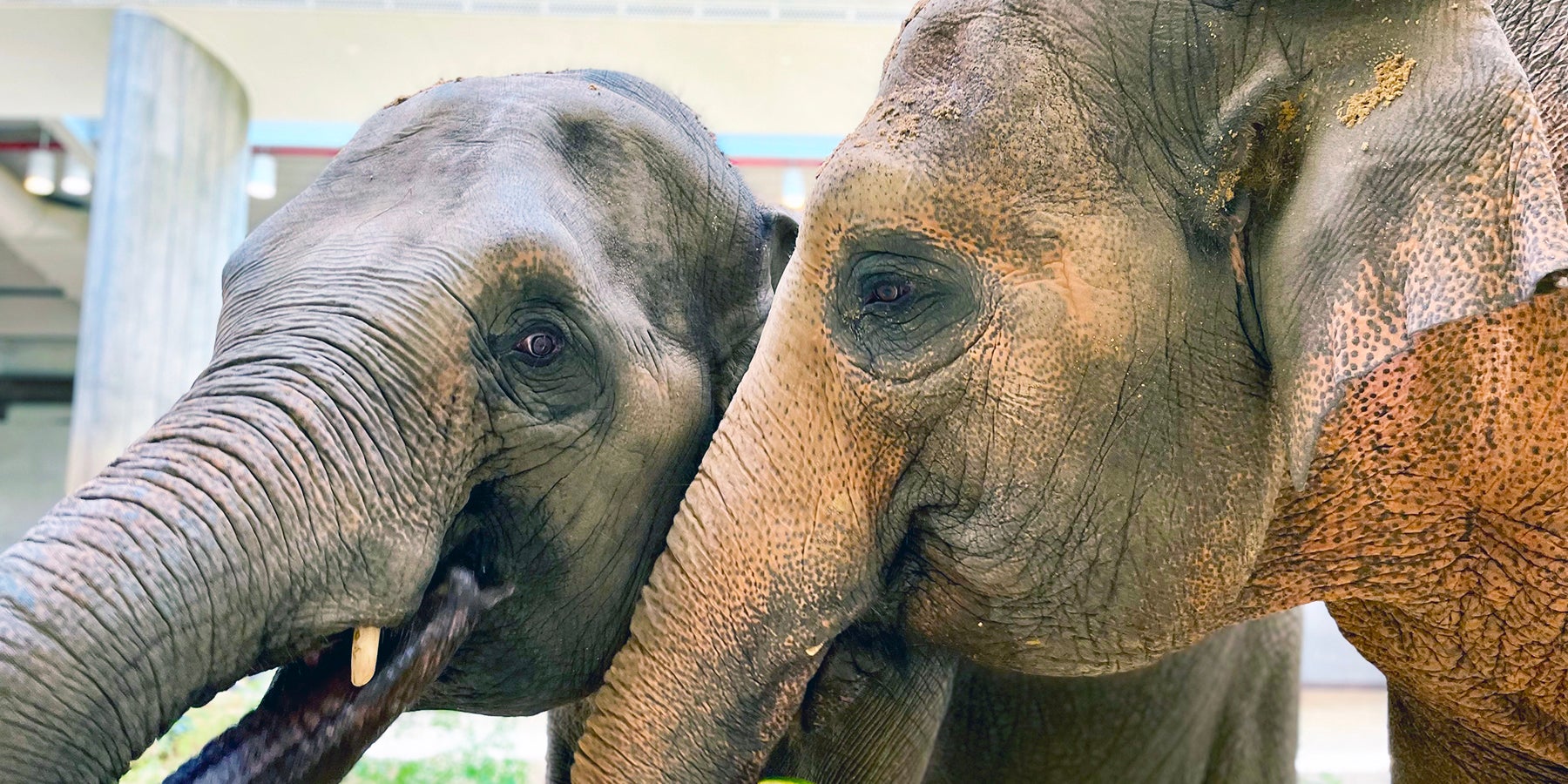
Elephant Cam
See the Smithsonian's National Zoo's Asian elephants — Spike, Bozie, Kamala, Swarna and Maharani — both inside the Elephant Community Center and outside in their yards.
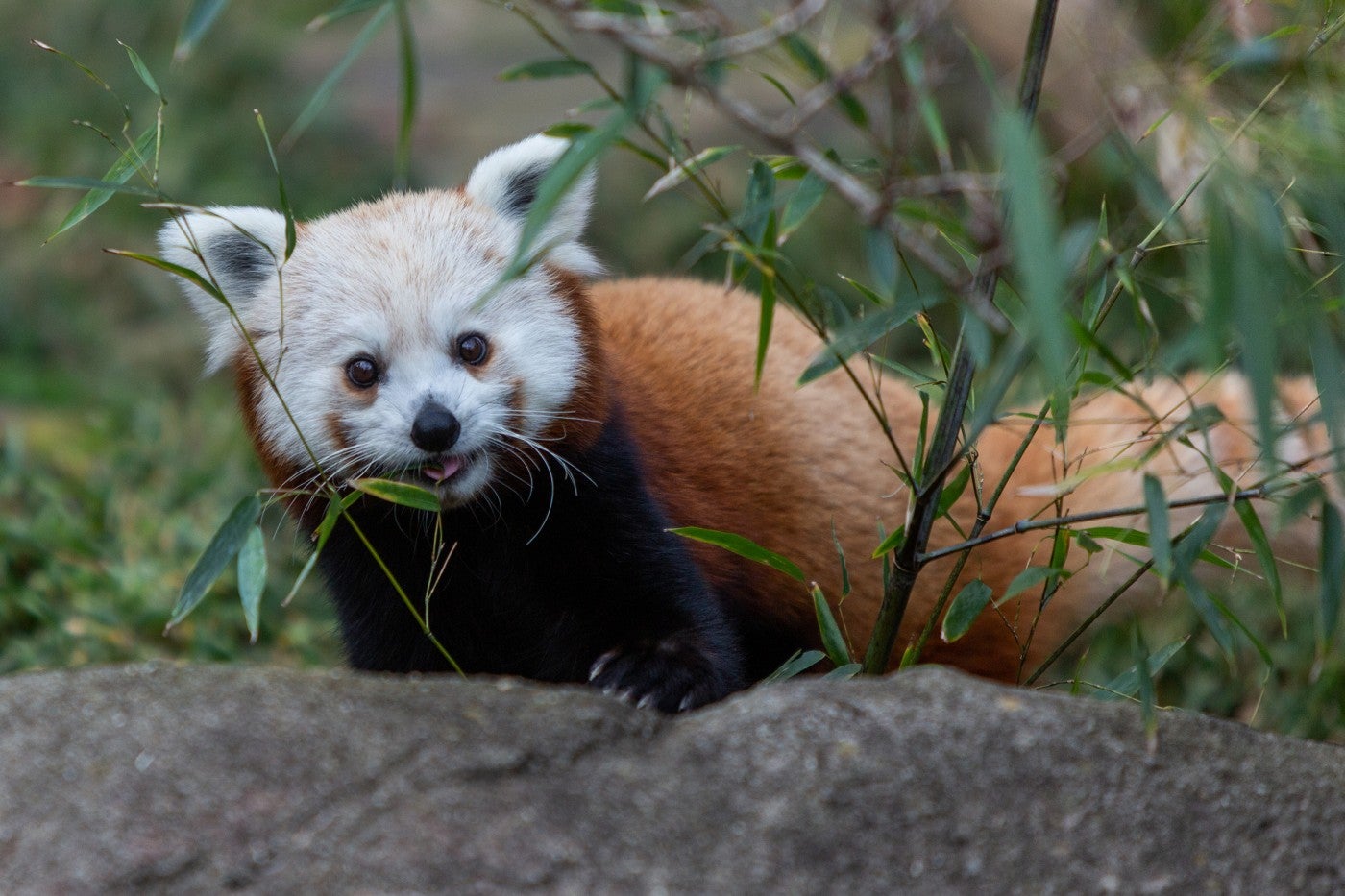
Now more than ever, we need your support. Make a donation to the Smithsonian's National Zoo and Conservation Biology Institute today!

Become a Member
Members are our strongest champions of animal conservation and wildlife research. When you become a member, you also receive exclusive benefits, like special opportunities to meet animals, discounts at Zoo stores and more.
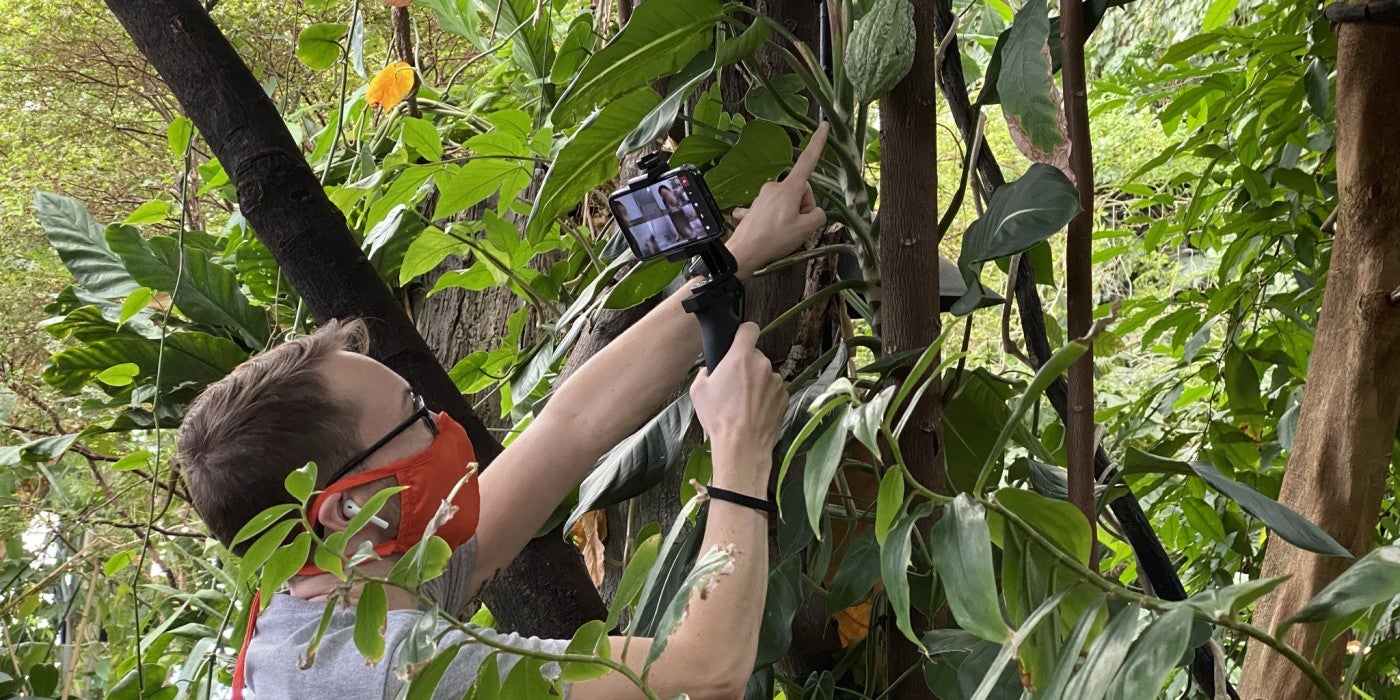
Education Calendar
Find and register for free programs and webinars.

About the Smithsonian Conservation Biology Institute
Hummingbirds
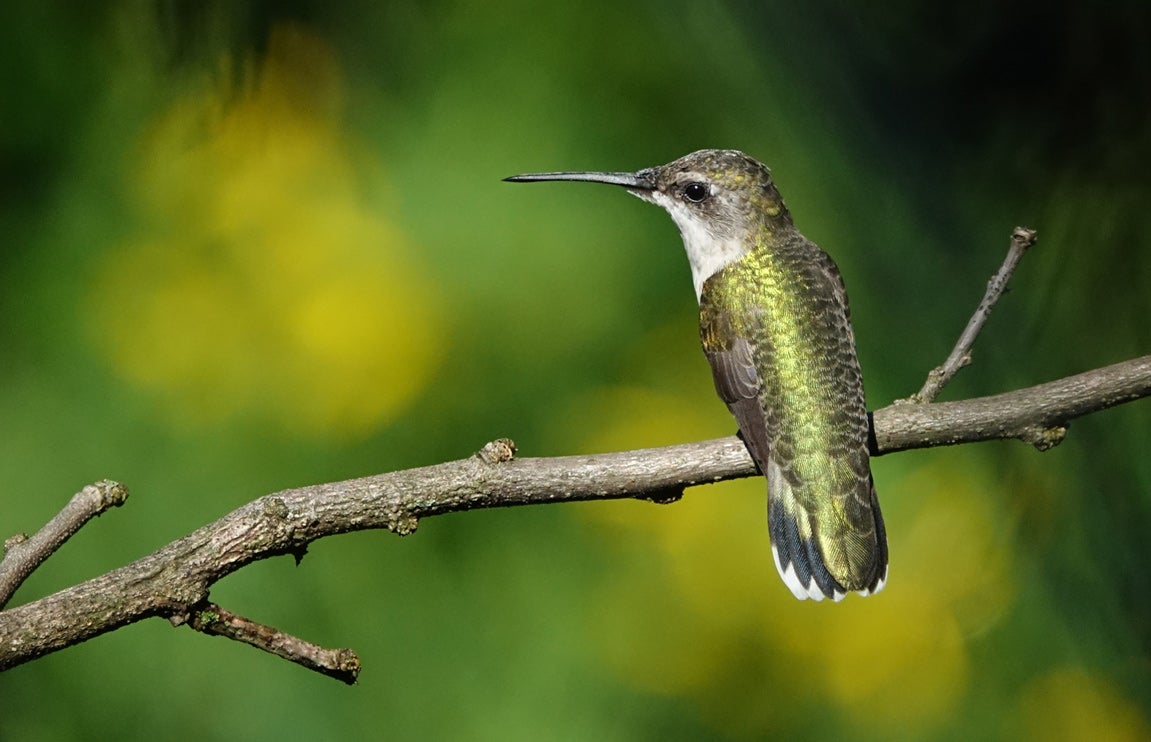
Tiny, pugnacious, jewel-like hummingbirds are relatively easy to attract to a garden and fun to have around. A careful look at hummingbirds provides a window into the elegance of adaptation in the natural world.
What is a hummingbird?
Hummingbirds belong to the avian family Trochilidae , and their closest relatives are the equally fascinating swifts. Hummingbirds are small (weighing 2 to 20 grams), with long, narrow bills and small, saber-like wings.
Males (and occasionally females) often have a colorful gorget—small, stiff, highly reflective, colored feathers on the throat and upper chest. These shiny feathers and others around the head may look sooty black until a hummingbird turns its head to catch the sun and display the intense, metallic spectral color.
Hummingbird Superlatives
The smallest birds.
The bee hummingbird of Cuba weighs only 1.95 grams, which means that, theoretically, 16 could be mailed first-class using just one stamp. The calliope hummingbird, the fourth-smallest bird, weighs in at a whopping 2.5 grams (less than an ounce) and can be found in the mountains of western North America.
The Tiniest Egg
It makes sense that the smallest birds come from the smallest eggs ... but how small? The one to two eggs in a ruby-throated hummingbird clutch are about as tiny as peas and are placed in a walnut shell-sized cup woven from spider webs and plant material.
The Avian Helicopter
Hummingbirds and swifts are able to stroke with power both on the down- and up-beat of a wing flap. Their power and small size allow tremendous agility in flight. In fact, hummingbirds are the only vertebrates capable of sustained hovering (staying in one place during flight), and they can fly backward and upside-down as well.
To their maneuverability, hummingbirds add speed and stamina. They have been clocked at close to 30 mph indirect flight and more than 45 mph during courtship dives. Migratory ruby-throated hummingbirds have no problem flying 18 to 20 straight hours to cross the Gulf of Mexico, powered by their fat stores and given a bit of help from winds.
Life in the Fast Lane
A ruby-throated hummingbird's heart beats from 225 times per minute when the bird is at rest to more than 1,200 times per minute when it is flying. Its wings beat about 70 times per second in direct flight and more than 200 times per second while diving.
Asleep on the Job
Hummingbirds are one of the few groups of birds that are known to go into torpor. Torpor is a very deep, sleep-like state in which metabolic functions are slowed to a minimum and a very low body temperature is maintained. If torpor lasted for long periods, we would call it hibernation, but hummingbirds can go into torpor any night of the year when temperature and food conditions demand it.
Hummingbirds are the masters of torpor, because they have to be. Their feathers offer poor insulation, and they have incredibly high metabolic demands. Torpor allows them to check-out physiologically when they cannot maintain their normal 105 degrees Fahrenheit body temperature.
Where Do Hummingbirds Live?
The almost 340 species of hummingbirds are entirely restricted to the New World, where they can be found from Tierra Del Fuego to southern Alaska and from below sea level deserts to steamy tropical forests at elevations of up to 16,000 feet in the Andes of South America.
Most species live in the tropics, and while 17 species regularly nest in the United States, many of these are found close to the Mexican border. Most areas in the U.S. have one or two breeding species, and only the ruby-throated hummingbird nests east of the Mississippi.
The Relentless Demand for Food
Their high-energy lifestyle compels hummingbirds to locate reliable food resources. Feeding on flowers puts hummingbirds at the mercy of the flowering seasons of the plants upon which they depend. Hummingbirds solve this by being very mobile, and their movements are often shaped by the changing pattern of flower production over time.
In the western U.S., hummingbirds migrate through the lowlands in the spring and return by way of the mountains in the summer to track the intense blooming of annual plants in meadows—moving ever-higher up the mountain as the summer progresses.
Hummingbirds don't always depend entirely on flowers. During the breeding season, in particular, hummingbirds hover mid-air and catch small flying insects to eat and feed to their nestlings.
In northern and high-elevation areas, hummingbirds depend upon sap-wells of woodpeckers known as sapsuckers. The woodpeckers are able to keep the sugary sap of trees flowing, and the hummingbirds sneak in to take advantage of the woodpeckers' work.
The Not-so-social Life of Hummingbirds
Hummingbirds are, for the most part, unsociable. In fact, the adjectives pugnacious and feisty are often appropriate. When more than one hummingbird is around, it is often a scene of repeated high-speed chases. In fact, male and female hummingbirds do not form a pair-bond after mating, and the female is left to care for eggs and chicks alone.
Hummingbirds do not need the help of other hummingbirds to locate food or fend off predators. Other hummingbirds are competitors for the flower nectar upon which they thrive. The help that a male might provide a female does not outweigh the burden of having a male around competing for food.
What is all this fighting about? Plants take time to secrete nectar into their flowers. In an ideal world, hummingbirds should time their visits to flowers to take advantage of a full load of nectar. But they wait to feed at a flower at the risk of other hummingbirds beating them to the punch. It is therefore worth the effort for hummingbirds to chase away competitors, so they have access and control of their favorite flowers.
In many cases, hummingbirds defend small territories around a favorite flower patch, and do so even during brief stopovers for refueling during migration. Where many species live together, the large species attempt to dominate flowers to get the biggest drinks of nectar, and smaller species try to sneak in for a few sips.
About the closest hummingbirds come to being social is in the tropics. The males of a small number of species form leks, places where they gather for months at a time and sing their scratchy hummingbird songs in an effort to attract females. The females are attracted to the leks, and the males then compete for the opportunity to mate.
The Whys and Whats of Hummingbird Flowers
Why do flowers attract special pollinators.
To be evolutionarily successful, flowering plants usually need their pollen carried from the stamens of one flower to the pistil of another so pollination occurs. This is accomplished in myriad ways. Some plants broadcast copious clouds of pollen that is carried by the wind to settle on cars, front porches and occasionally on a plant of the same species.
Many other plants produce few pollen grains and attract specific kinds of animals. By providing a nectar reward in a flower that keeps out a lot of animal competitors, there is a good chance the pollinating species will search out another like flower and pollination will occur.
What it takes for a flower to attract hummingbirds
Flowers that attract hummingbirds:
- Provide a large amount of nectar with a substantial sugar content to support the demanding hummingbird lifestyle. Sugar content averages about 26 percent, which is double the sugar found in a soft drink. But the nectar cannot be too concentrated and sticky, because hummingbirds rely on a long, tube-like tongue to draw nectar into their mouths through wicking action (the force that brings water up a straw when the straw is stuck in a glass).
- Tend to have red or orange petals or bracts, which provide a long-distance sign to a fast-flying hummingbird that it should take notice
- Are often long and tubular, so a long, narrow bill and tongue are required to extract the nectar
- Often hang down and point downward, so a hovering bird has the easiest access
- Have long stamens that deposit the pollen on the forehead of the unsuspecting bird
Most hummingbirds are not super specialized and will feed at a wide variety of flowers, preferring the hummingbird flowers described above. However, throughout the tropics are examples of very tight, co-evolved hummingbird-flower relationships in which the bill of the hummingbird fits the highly modified flowers almost like a key that opens a lock.
How Can You Help Hummingbirds?
Make your backyard a hummingbird restaurant.
The life of a hummingbird consists of a relentless search for food. In areas settled by humans, the flowers that hummingbirds have evolved to hunt down and suck dry often disappear.
The good news is that the lost natural food sources can be easily replaced by planting the right plants and providing sugar water in hummingbird feeders .
Some good hummingbird plants include:
- Cardinal flower
- Trumpet creeper
- Coral honeysuckle
Drink a Cup of Hummingbird Friendly Coffee
More than half of the species of hummingbirds live in the tropics. Even favorite backyard species migrate to the tropics, where they spend the greatest portion of the year. In the tropics, hummingbirds often move up and down mountains and between arid and moist habitats to keep up with where the trees and shrubs are flowering.
Coffee is often grown halfway up tropical mountains, the crossroads for the variety of species traveling to find flowers. When grown under a diverse canopy of shade trees, coffee plants, the trees that shade them and the plants that grow on the trees provide a smorgasbord of flower resources.
It is no wonder that shaded coffee farms can support impressive numbers of hummingbird species. In one coffee-growing region in Peru, Smithsonian Migratory Bird Center scientists recorded 24 species over the course of a year. Ruby-throated hummingbirds are also abundant in coffee farms in Mexico and Central America during their time in the tropics.
By drinking certified Bird Friendly® coffee , you help guarantee that coffee is grown on farms that feature the flowers that hummingbirds depend upon.

27 Common Hummingbird Species & Types
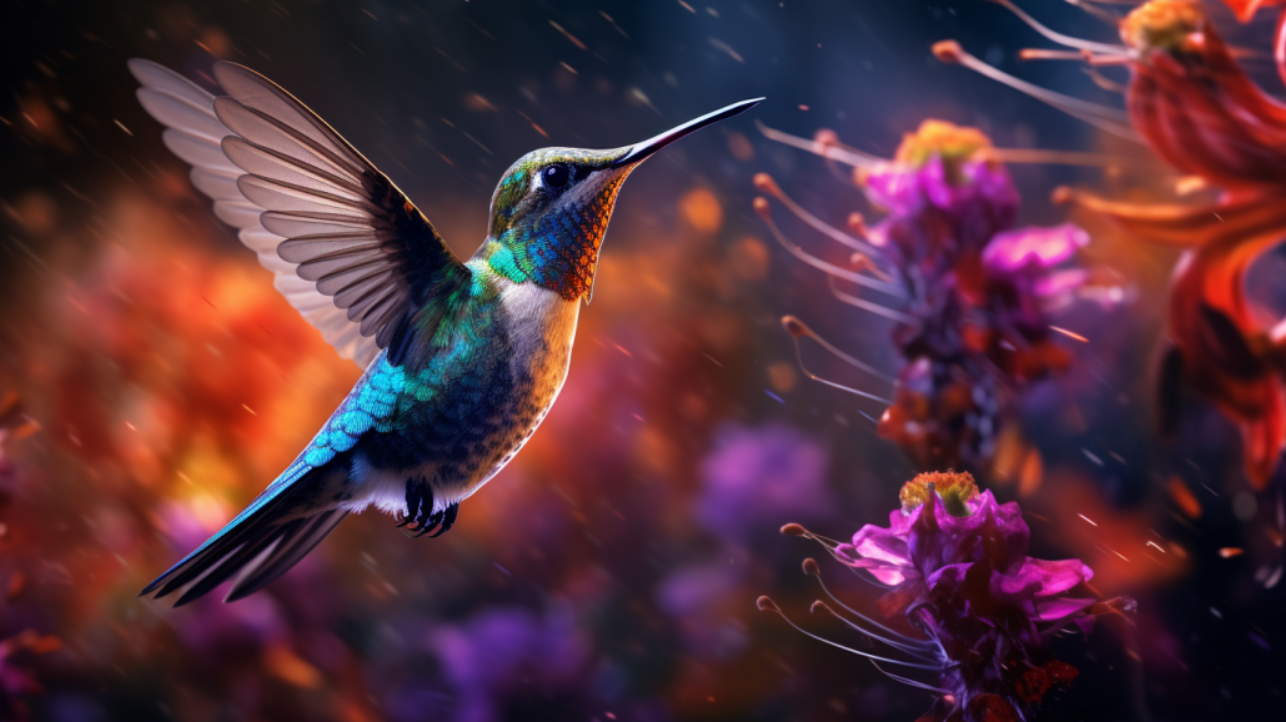
Hummingbirds showcase an incredible diversity of colors, sizes and adaptations. Their diminutive size belies an adventurous spirit, with many species undertaking incredible migrations and surviving extreme conditions. Hummingbirds primarily exist in the Americas, occupying habitats from Alaska to Chile. While specialized nectar feeders, they play an integral role as pollinators. This article explores 28 of the most widespread and familiar hummingbird species. From the Ruby-throated Hummingbird gracing Eastern gardens to the energetic Rufous dashing about Western wildflower meadows, be captivated by the beauty and behaviors of these smallest of birds.
Table of Contents
1. Ruby-throated Hummingbird
2. anna’s hummingbird, 3. rufous hummingbird, 4. allen’s hummingbird, 5. calliope hummingbird, 6. broad-tailed hummingbird, 7. costa’s hummingbird, 8. violet-crowned hummingbird, 9. black-chinned hummingbird, 10. lucifer hummingbird, 11. berylline hummingbird, 12. buff-bellied hummingbird, 13. white-eared hummingbird, 14. magnificent hummingbird, 15. white-eared hummingbird, 16. xantus’ hummingbird, 17. long-billed starthroat, 18. plain-capped starthroat, 19. white-bellied emerald, 20. green-breasted mango, 21. amethyst-throated hummingbird, 22. bahama woodstar, 23. sapphire-spangled emerald, 24. bahama woodstar, 25. green violet-ear, 26. long-billed hermit, 27. saw-billed hermit, full list of hummingbird breeds, types & species.
The Ruby-throated Hummingbird is one of the most widespread and commonly seen hummingbirds in North America. Identifiable by its bright emerald green back, white breast and metallic red throat (gorget) on the males, this petite bird breeds across Eastern North America and migrates all the way to Central America for the winter. Ruby-throats are solitary, territorial birds that stake out feeding areas in gardens and woodland edges. They have an incredibly fast metabolism and need to consume nectar frequently throughout the day from flowers and feeders. Their wings beat up to 80 times per second! Though small, these feisty hummingbirds will aggressively defend their territory, even chasing away larger birds.
Ruby-throated hummingbirds build delicate cup-shaped nests out of soft plant down, spider webs and lichens. The female alone builds the nest and cares for the young. She lays 2 pea-sized white eggs and incubates them for 14-16 days. The chicks fledge in 18-22 days. Ruby-throats are resilient migrants that make the 500 mile journey across the Gulf of Mexico in one nonstop flight. Though widespread, they are declining slightly in number due to habitat loss and fewer natural food sources. Planting native nectar-producing flowers and providing clean feeders can help them thrive.
Anna’s Hummingbird is a medium-sized hummingbird named after a 19th century duchess. It is among the most common hummingbirds found along the Pacific Coast from southern British Columbia to Baja California. The male has an iridescent emerald green back and crown, grey underparts and a brilliant magenta throat. Females lack the iridescent colors and have grey-green underparts and white tips on the tail feathers.
One unique quality of Anna’s Hummingbird is its ability to withstand cold temperatures. It is the only hummingbird species commonly found through the winter in cooler climates as far north as Canada, surviving freezing nights by lowering its metabolic rate and entering a state of torpor. Anna’s hummingbirds feed on nectar, tree sap, and small insects. They use their slender pointed bills to pierce flowers at the base of the corolla. Favorite nectar sources are tubular flowers of the trumpet vine, coral honeysuckle and certain sages. The species was named after Anna Massena, Duchess of Rivoli.
The Rufous Hummingbird is one of the most widespread western hummingbirds known for its spectacular migratory journey. They breed farther north than any other hummingbird, nesting along the Pacific Northwest coast up through Alaska during summer months. As flowers fade and cold weather arrives, Rufous Hummingbirds embark on a 3,900 mile migration to Mexico – the longest migration of any hummingbird species relative to its size.
The males have a bright orange-red throat and may appear entirely reddish-orange in bright light. Females have green backs, white bellies and spotted throats. Rufous hummingbirds are extremely active and territorial. They chase off intruders and dive at threats while making a sharp tee-tee-tee vocalization. Though tiny, they will confront even the largest birds if encroached upon. A forest opening with wildflowers or a garden with nectar plants and feeders make ideal habitat for this migratory species.
The Allen’s Hummingbird is a small green hummingbird with an iridescent orange throat, rufous sides and tail feathers found along the Pacific Coast. The males are identified by their brilliant orange-red throat while females have green backs, grey-white undersides and rufous spotted tail feathers. Allen’s hummingbirds are migratory, breeding in coastal California and southern Oregon before migrating to Mexico for winter.
This species prefers semi-open areas near streams or meadows with scattered trees and bushes as well as parks and gardens. They build tiny meticulous cup nests and may reuse them year after year. Allen’s hummingbirds feed on nectar, tree sap, spiders and insects. They use a feeding technique called trap-lining, establishing favorite nectar sources and revisiting them periodically throughout the day. Though territorial, they may allow other hummingbird species to share their feeding area.
The Calliope Hummingbird is the smallest breeding bird in North America and one of the smallest in the world, weighing less than a nickel. Males have bright magenta throats, crowns and whisker streaks, a white breast band and greenish backs. Females lack iridescent throat patches and are more pinkish-white below with green backs.
This tiny hummingbird breeds in the mountains of western North America and winters in Mexico. Calliopes prefer open habitats with scattered shrubs and trees such as meadows and pine forests edge. They feed on nectar, tree sap, spiders and tiny insects which they glean from flowers and leaves. Their tiny size allows them to hover while feeding and extract nectar from flowers many other pollinators cannot access.
Calliope hummingbirds build tiny mossy nests in low branches, often overhanging streams. They lay only 2 tiny white eggs. The species name comes from the mythical muse Calliope, reflecting the male’s beautifully musical courtship display flights. Though one of the smallest birds in the world, they make an incredibly arduous migratory journey all the way to Mexico.
The Broad-tailed Hummingbird is a medium-sized hummingbird named for the male’s wide fan-shaped tail. It is common in mountain meadows and forests of the western United States. Adult males have a brilliant iridescent rose-pink throat patch, white chest band and body and a metallic green back. Females lack the bright throat patch and are more dingy white below with greenish backs and white-tipped tail feathers.
Broad-tailed hummingbirds breed at higher elevations and migrate short distances to Mexico for winter. They prefer open mountain habitats with wildflowers, ponderosa pines and aspens. This species can be attracted to gardens by planting tubular red flowers and providing sugar-water feeders. The broad tail of the male produces a loud trilling noise in flight that descends in pitch. The species often breeds near rushing streams.
Costa’s Hummingbird is a desert hummingbird named after its 19th century discoverer, French nobleman Louis Marie Pantaleón Costa. A small hummingbird with a very short bill, the male Costa’s has an iridescent violet crown and throat with a dark purplish flare behind the head. Females lack the bright colors and their underparts may be whitish to pale grey-brown. Costa’s hummingbirds are primarily found in the Sonoran and Mojave Deserts of southwestern USA and northern Mexico.
This desert-adapted species frequents dry washes, desert scrub and succulent filled gardens. They visit ocotillo, palo verde, barrel cactus, agave and chuparosa for nectar. Costa’s hummingbirds also include spiders, insects and tree sap in their diet. They build nests along dry branches providing shade but may nest close to human habitation. The species is named after ornithologist Louis Marie Pantaleón Costa who collected natural history specimens in California in the late 1800s.
The aptly named Violet-crowned Hummingbird has a gleaming violet crown that appears black until struck by direct sunlight. It is found along the Pacific Coast and in the mountain ranges of Mexico and Central America. Adult males are bright green above with a violet crown, white underparts and a red-orange bill. Females are dull white below with green backs and lack a colored crown.
Violet-crowned hummingbirds occupy canyons and foothills with sycamores, pines and agaves. They visit colorful tubular blossoms of shrubs and trees such as fuchsia, trumpet vine, coral bean and ocotillo to feed on nectar. They also hawk flying insects. This hummingbird’s tiny nest is made of downy plant fibers and often located near water on a tree branch. Though range limited in the USA, this species is common within its core habitat.
The Black-chinned Hummingbird is a small western hummingbird named for the dark, pencil-thin throat band on adult males. This purple-black chin stripe is bordered by an iridescent green throat patch and white below. Females lack the colored throat and are pale grey underneath with green backs.
This species breeds across western North America and migrates to Mexico for winter. Black-chinned hummingbirds prefer brushy areas, canyons and stream-sides as well as parks and gardens. They feed at the base of tubular flowers with their extendible tongues. Some favorite nectar sources are Indian paintbrush, penstemon, fuchsia and beebalm. Though diminutive, the males are highly territorial and make bold dive displays.
The Lucifer Hummingbird is a stunning species endemic to dry subtropical forested slopes in northern Mexico. Adult males are brilliant gold-green above with a violet-blue throat, purple crown and long curved bill. Females are greyish white underneath with green backs. The name “Lucifer” refers to their fiery brilliance.
This range-restricted hummingbird lives in oak and pine-oak woodlands near mountain streams and canyons. They visit colorful tubular flowers such as morning glory, agave, trumpet vine and honeysuckle. Lucifers build tiny cup nests along drooping branches. Part of their habitat coincides with the monarch butterfly’s wintering grounds in Mexico to which they time their migration. Lucifer Hummingbirds play an important role pollinating the forest understory.
The Berylline Hummingbird is an elegant hummingbird of Mexico and the Southwestern USA distinguished by its yellowish underparts. Adult males have a brilliant orange bill, iridescent green crown and nape, bold white eye stripes and grey underparts. Females have grey-green crowns, lack the bold face pattern and are more grayish below.
These hummingbirds breed in pine-oak forests and canyons of the southwest mountains and winter along Mexico’s Pacific coast. They prefer mountains and foothills with agaves, flowering shrubs and oak groves. Berylline hummingbirds probe flowers with their long decurved bills and visit hummingbird feeders as well. They build tiny cup nests in trees along forested streamsides. This species is declining due to loss of mountain habitat.
The Buff-bellied Hummingbird is one of the most common species in the pine and pine-oak forests of Mexico and Guatemala. As its name suggests, it has a striking buff or cinnamon colored underside. The males also have an iridescent turquoise-green throat patch while females have a speckled throat with some metallic feathers. Both sexes have a thin dark bill and notched tail.
Buff-bellied hummingbirds aggressively defend flowering trees and shrubs along forest edges, second-growth scrub and gardens. They get most of their nutrition from flower nectar but also eat small spiders and insects. Favorite nectar sources include century plants, jacobinias, and various Salvias. The species migrates only short elevational distances between breeding and wintering habitat. Loss of native forest habitat is resulting in some decline of buff-bellied hummingbird populations.
The White-eared Hummingbird is an emerald hummingbird with bold white ear tufts found in the pine-oak and fir forests of Mexico and Central America. Adult males are brilliant green above with a violet throat, blue-white ear tufts and black and red bill. Females are less colorful with whitish undersides, green backs, white-tipped tail feathers and lack ear tufts.
White-eared hummingbirds aggressively defend flowering trees and shrubs along the forest edge. They use their long needle-like bills to probe tubular flowers and extract nectar and insects. Some favorite food plants are century plants, Esperanza, and various Salvias and hummingbird bushes. The species migrates short elevational distances between montane tropical regions. Habitat loss is reducing its population.
The aptly named Magnificent Hummingbird is one of the largest and most striking hummingbirds in North America. Males are unmistakable with their iridescent rose-pink throat and crown, dark green back, and long tapered tail. Females are smaller and lack the bright pink gorget, instead having pale grey underparts and green backs.
Magnificent hummingbirds breed in mountain canyons and forests of the southwest United States and Mexico. In summer they are found in high elevation meadows and pine-oak forests abounding with flowers. Come winter they migrate to Mexico’s western coast. This large hummingbird has a bold, aggressive disposition. They fiercely defend flower clumps and feeders from intruders with fast chases and dive displays.
Magnificent hummingbirds have a swift direct flight and can reach speeds of up to 50 mph. Their wings beat 55 times per second! They feed on nectar from vibrant tubular flowers of shrubs, trees and cacti. Some favorites are red hot pokers, penstemons, pineapple sage and agaves. The musical metallic trills of the males can be heard during courtship displays. Though still common, habitat loss in their limited range is a concern for this spectacular hummingbird’s future.
White eared hummingbirds usually thrive in high tropical mountains. They rarely breed in the US. The average weight of the male white-eared is 3.6 g, while that of the female is 3.2 g.
The adult male white-eared hummingbird has an emerald green back and breast, a purplish crown, blue-green chin, whitish ear stripe, and a red bill with a black tip. On the other hand, its female counterpart has a green back and crown, white breast and sides with streaks of green, and a characteristic white ear stripe. Its bill has a reddish colour that comes with a black tip, just like the male.
The Xantus’s Hummingbird is a small western hummingbird named after Hungarian zoologist John Xantus who first collected it in Mexico. Males have a brilliant iridescent purple-green throat and crown, white breast band, and green flanks. Females lack the bright throat patch and are more grayish-white underneath with green backs.
This species breeds in the arid scrublands of the Baja California Peninsula and winters on the mainland of Mexico. It inhabits dry washes, desert scrub and oases with agaves, ocotillos, and other flowering desert plants. Xantus’s hummingbirds have a quick, chipping call. They feed on nectar from colorful tubular blossoms and flowering cacti. Some favorite plants include Fairy Duster, Desert Lavender, and Chuparosa.
Xantus’s hummingbirds build tiny delicate nests in the branches of desert trees and shrubs. Like other desert hummingbirds, they are specially adapted to thrive in hot, arid environments. They defend feeding territories around flowering plants. This species is currently declining due to habitat loss and drought. Planting native flowering plants can help provide food sources for these desert-loving hummingbirds.
The Long-billed Starthroat is a large hummingbird with a very long straight bill found from Mexico to Costa Rica. It prefers lower mountain slopes, open woodland, second growth scrub and gardens. Adult males have a violet throat bordered by irridescent blue ear patches, a straight bill and plain crown. Females lack the bright throat patch and are more olive green above.
As its name indicates, the Long-billed Starthroat has an exceptionally long bill adapted for drinking nectar from long tubular flowers. Some favorites in their habitat includeCalliandra, Pithecoctenium and various orchids. The male displays by flying in loops up to 130 feet in the air while singing a sharp staccato “chip” call. Though still common, habitat loss could impact this species.
The Plain-capped Starthroat is a medium-sized hummingbird with a distinctive shape found from Mexico to Costa Rica. Its long straight bill and long wings give it a very streamlined silhouette. Males have a glittering violet-blue throat patch and crown, white breast and a plain cap. Females lack the colorful throat patch. This species prefers tropical deciduous forest, forest edges, second growth scrub and gardens.
Plain-capped starthroats mainly feed on nectar taken from flowers such as firecracker plant, coral vine and various wild Salvias. They also occasionally eat small insects. The species produces a sharp “chip” call when defending its territory. Plain-capped starthroats build tiny cup nests on twigs overhanging streams. Currently they are still common within their range but habitat loss could pose a threat in the future.
The White-bellied Emerald is a striking green hummingbird with a bright red bill and loud whistling display. Native to humid tropical forests in Central America and northern South America, this species prefers forest edges, second growth scrub, parks and gardens. The long bright red bill of the male is used to produce a whistling “peeeoo” display. Females have shorter all-black bills. Both sexes have brilliant green upperparts and white underparts that appear grey-tailed in poor light.
White-bellied emeralds sip nectar through their long bills from flowers such asHeliconia, ginger plants and flowering brush. They build tiny lichen-covered nests near streams. Though still common, habitat loss in some areas poses a threat. The species occurs locally in lowland areas of the Neotropics, ranging from Mexico to Amazonian Brazil and Peru.
The Green-breasted Mango is an exotic looking hummingbird with a bright purple crown and glossy green undersides. The males have an iridescent purple head and throat, black masked face and a deeply forked purple-black tail. Females are similar but less colorful. This species is found in tropical regions of Mexico, Central and South America in forest edges and second growth.
Green-breasted mangos use their specialized long bills to drink from flowers with deep corollas like Heliconia. They also take nectar from brush flowers and visit banana feeders. Their feeding territories are aggressively defended. Pairs perform dramatic courtship flights together. The species is common but threatened by habitat loss. Its striking beauty makes it one of the most popular hummingbird species in captivity.
The Amethyst-throated Hummingbird is a tiny jewel-colored hummingbird restricted to the forests of Costa Rica and western Panama. Males have a glittering amethyst-purple throat and crown, black auriculars and an iridescent green back. Females are greener with white underparts. This endangered species is threatened by habitat loss and capture for the pet trade.
Amethyst-throated hummingbirds inhabit the canopy of mature lowland rainforests and dense second growth. They feed on nectar from small flowers of epiphytes and trees within the forest, not coming regularly to ground level. Remaining populations are now found mainly in protected areas. However, some illegal trapping for the pet trade still occurs. Overall numbers continue to decline.
The Bahama Woodstar is a tiny hummingbird only found in the Bahama Islands. At just 2.5 inches long, it is the smallest breeding bird in the Bahamas. Males have a long straight bill, iridescent violet-blue crown and throat, short forked tail and white below. Females are duller with white-tipped outer tail feathers. This species inhabits pine and coppice woodlands, gardens and mangroves on the islands.
Bahama woodstars primarily feed on nectar from small tubular flowers of trees, shrubs and herbs. They use their specialized long bills to access the nectar. Some favorite plants include Firebush, Turk’s Cap Cactus and Brazilian Pepper. They also drink from nectar feeders. These tiny hummingbirds are territorial and aggressively chase intruders while making a high-pitched twittering noise. The Bahama Woodstar is considered endangered due to habitat loss from development and storms.
The Sapphire-spangled Emerald is a stunning blue and green hummingbird found along the Carribean coasts of Central America. Males are bright turquoise blue above and white below with blue-tipped tail feathers. Females are duller green with white tips on the tail feathers. This species inhabits coastal scrublands, edge of mangrove forests and gardens.
Sapphire-spangled emeralds feed on nectar from flowers of trees, shrubs and vines. They use brush-tipped tubular flowers and also visit feeders. Some favorite natural sources are Firecracker plant, Coral Vine and Angel’s Trumpet. The brilliant plumage of the male produces a beautiful sapphire and emerald flash in flight. This species has a very small global range and is threatened by habitat loss from tourism development.
The Green Violet-ear is an elegant green hummingbird with violet ear patches found from Mexico to Panama. Adult males are bright green with a blue-violet ear patch and glittering blue-violet throat. Females are duller green with grey underparts. This species inhabits tropical lowland rainforests, forest edges and adjacent gardens.
Green violet-ears prefer to feed high in the forest canopy on nectar from epiphyte flowers and gems. They only occasionally come to lower flowers such as heliconias. Their technique of clinging vertically to flower clusters sets them apart from other hummingbirds. This species makes seasonal elevational migrations following flower blooms. It is currently threatened by deforestation.
The Long-billed Hermit is the only hummingbird with a long slightly upturned bill adapted for collecting nectar from long narrow flowers. This chunky green hermit occurs in tropical forests from Mexico to Bolivia. Males of this species are velvety green above with a blue-violet patch below the eye. Females are duller green with buffy underparts.
The Long-billed Hermit uses its specialized beak to access nectar from specialized flowers with long corollas such as passionflowers and leret flowers. Their feet have strongly curved claws that allow them to cling vertically to flowers while feeding. They live alone in dark forest understory and subcanopy. Destruction of rainforest habitat threatens this species.
The Saw-billed Hermit is a rare Central American hummingbird named for its unique serrated bill tip. This chunky green hermit has a brilliant red-orange bill in males and a strongly hooked black bill in females. It inhabits subtropical evergreen forest and oak groves in the mountains of Costa Rica and Panama.
The saw-billed hermit uses its specialized bill to open up the base of long tubed flowers and access the nectar inside. Heliconias and angel’s trumpets are among their favorites. They also take small insects. Little is known about this rare species’ habits and breeding. Loss of mountain forest habitat is reducing its limited range. The saw-billed hermit population is believed to be decreasing but the species has been designated as Near Threatened.
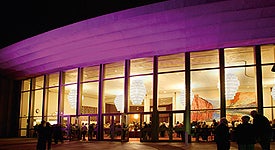
Explore Chandler
Chandler's parks, pools, museums, art galleries, hotels, resorts, golf courses, restaurants and ample shopping opportunities make this one of Arizona's great cities to live, play and work.
- About Chandler
- Centers and Pools
- Diving Program
- Jobs in Aquatics
- Policies, Rules & Regulations
- Register for Classes
- Spray & Splash Pads
- Swim Lessons
- Water Fitness
- #WaterYouDoing
- Center for the Arts
- Chandler Museum
- History of Chandler
- Vision Gallery
- Business Resources for Downtown Chandler
- New Developments in Downtown Chandler
- Parking in Downtown Chandler
- Things to Do in Downtown Chandler
- Parks Guide
- Park Programs
- Projects & Public Meetings
- Break Time Magazine
- Centers and Facilities
- Jobs in Recreation
- Programs and Activities
- Rec At Home
- Applications
- Diversity Events
- #iChooseChandler
- Plan a Meeting
- Restaurants
- Things to Do

Chandler Residents
We want you, as a resident of Chandler, to easily find the information and services that are important to you.
- Chandler A to Z
- Bail, Sanctions and Civil Fines
- Court Case Search
- Civil Traffic/Parking Fines
- Court Payments
- Find My Case
- Orders of Protection
- City Improvements
- Career Opportunities
- Community Outreach
- Crisis Response Unit
- Fire Prevention
- Safety Education
- Community Development
- Housing & Redevelopment
- Neighborhood Preservation
- Permits and Plan Reviews
- Bulk Pickup
- Commercial Trash Service
- Education and Outreach
- Household Hazardous Waste
- Recycling Solid Waste Collection Center
- Residential Trash Collection Schedule
- Reuse/Donation Options
- Traffic Management
- Transportation Policy
- Acts of Kindness
- Utility Rates
- Water Conservation
- Water Quality

Chandler is Open for Business
Chandler boasts a number of advantages as a location to start or grow a business.
- Businesses and Services
- Pilots and Tenants
- Capital Projects
- Tribal Grants
- Why Choose Chandler
- Business Services
- Employment & Business Districts
- Key Industries & Employers
- Data & Maps
- News & Events
- Permits & Plan Reviews
- Planning & Zoning
- Applications & Forms
- Business Registration
- General Tax
- Rental Properties
- Registration & License Renewals
- Short-Term Rental

A Message From:
Mayor kevin hartke.
Welcome to Chandler, Arizona, the Community of Innovation. Come meet Mayor Kevin Hartke and the members of the City Council .
Mayor and Council
- Boards & Commissions
- Bond Election
- Budget & CIP
- City Code and Charter
- City Council Meetings
- 2023 - 2025 Strategic Framework
- Performance Dashboards
- Diversity, Equity & Inclusion
- Mission and Values
- Strategic Initiatives
- City Clerk's Office
- Communications and Public Affairs
- Community Services
- Development Services
- Human Resources
- Information Technology
- Management Services
- Campaign Finance Reports
- General Plan
- Mayor Initiatives
- Sustainability
- Choosing Chandler Blog
- CityScope Newsletter
- News Center
- Voices of Chandler
- Hummingbird Habitat at Desert Breeze Park
- Parks in Chandler
- Guide to Chandler Parks
- Desert Breeze Park
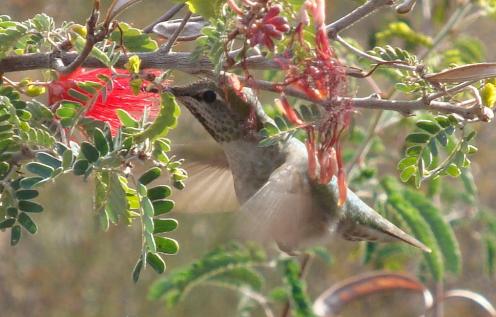
The Hummingbird Habitat at Desert Breeze Park demonstrates the beauty of native and desert-adapted plants in a shady and inviting garden. It is a beautiful space to learn about desert plants and is a point of pride for Chandler residents. It is open to the public every day of the year. By walking the garden paths, you'll see plants at their mature size, find examples of good plant combinations and discover ideas for your landscape.
It was designed by Landscape Architect Dennis Peltz to demonstrate a low-maintenance landscape full of color, fragrance, interesting textures, coveted shade and features over fifty varieties of water-efficient plants that attract hummingbirds, butterflies and other wildlife. When you enter the habitat you are immediately surrounded by the beauty of native and desert-adapted plants in a shady and inviting garden, including the subtle sound of falling water from a hidden water feature.
Established from a water retention area in the back corner of the park, the water feature provides a cooling effect as well as a drinking and bathing source for birds. Near the center of the garden is a large, artificial iron tree with a bench around its base providing a 360-degree opportunity to bird watch in the shade.
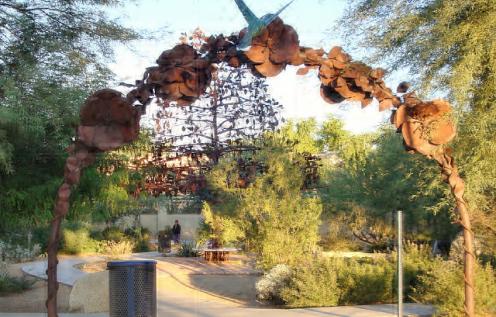
One of the first things you will notice when entering the garden are the two large iron sculptures by artist Joe Tyler. One piece is an archway with a hummingbird collecting nectar from a flower and the other is a large tree that serves as a shade structure to the surrounding seating area. These sculptures were selected by the Chandler Arts Commission. Chandler High School art department students designed and constructed the ceramic tile artwork on the entry signage.
The Hummingbird Habitat is part of Desert Rivers Audubon's Bird Habitat Recognition program and is lovingly maintained by their volunteers. No pesticides are applied in the Hummingbird Habitat as they could impact the health of the birds but even more of a concern, they would eliminate their food sources including insects and seeds.
To create the hummingbird habitat, plant materials were donated by local nurseries and the plants were installed by boy scouts, girl scouts, Intel employees, Chandler Parks Department employees, Chandler residents, and special Olympic volunteers. The Chandler Lions Club provided the walkways and the Soroptimist International of the San Tans funded two benches.
For more information on creating a landscape to attract hummingbirds and butterflies, visit Chandler Water Conservation .
Spring 2024 Hummingbird Sightings and Migration Map
The urge to migrate.
Many hummingbirds spend the winter in Central America or Mexico, and migrate north to their breeding grounds in the southern United States as early as February, and to areas further north later in the spring.
Hummingbirds fly by day when nectar sources such as flowers are more abundant. Flying low allows the birds to see, and stop at, food supplies along the way. They are also experts at using tail winds to help reach their destination faster and by consuming less energy and body fat.
Research indicates a hummingbird can travel as much as 23 miles in one day. However, during migration as they cross the Gulf of Mexico they may cover up to 500 miles at a time. Their average speed in direct flight is in the range of 20-30mph, and up to three times that fast during courtship dives.
During migration, a hummingbird's heart beats up to 1,260 times a minute, and its wings flap 15 to 80 times a second. To support this high energy level, a hummingbird will typically gain 25-40% of their body weight before they start migration in order to make the long trek over land, and water.
The first arrivals in spring are usually males. Some, however, do not migrate, in areas like California and the upper Pacific coast, the southern parts of the Gulf of Mexico states, and some along the southern Atlantic Ocean areas.
Highlights of 2024 Migration Activity
We typically track the spring hummingbird migration from late-January to mid-May of each year, with the help of our viewers as they submit their first hummingbird sightings in their areas.
Policies for Reporting Sightings
Here are some points and policies to note about the posting of reports on our migration map:
More About the Spring Hummingbird Migration
During migration, a hummingbird's heart beats up to 1,260 times a minute, and its wings flap 15 to 80 times a second. To support this high energy level, a hummingbird will typically gain 25-40% of their body weight before they start migration in order to make the long trek over land, and water. They fly alone, often on the same path they have flown earlier in their life. Young hummingbirds must navigate without parental guidance.
Hummingbirds fly by day when nectar sources such as flowers are more abundant. Flying low allows the birds to see, and stop at, food supplies along the way. They are also experts at using tail winds to help reach their destination faster and by consuming less energy and body fat. Research indicates a hummingbird can travel as much as 23 miles in one day.
Strong cold fronts moving south over the Gulf of Mexico make flying difficult as the birds deal with headwinds and heavy rain, over long distances with no shelter. Food is non-existent over the open waters.
Read more details about hummingbird migration
The Fall Hummingbird Migration
By August and September, hummingbirds are moving south, refueling their bodies in the early morning, traveling midday, and foraging again in the late afternoon to maintain their body weight.
Ruby-throats gather in Florida, Louisiana and along the South Texas coast in September in preparation for the final push to the south, either over the Gulf of Mexico or via an overland route through Mexico. The Rufous hummingbirds head south, most via the eastern range of the Rocky Mountains. Read more about the fall migration of hummingbirds
Popular Hummingbird Feeders This Year
SITE MAP | PRIVACY POLICY | TERMS OF USE | CONTACT US
Copyright © 2024 HummingbirdCentral.com • All Rights Reserved.

10 Species of Hummingbirds in Utah – Picture and ID Guide
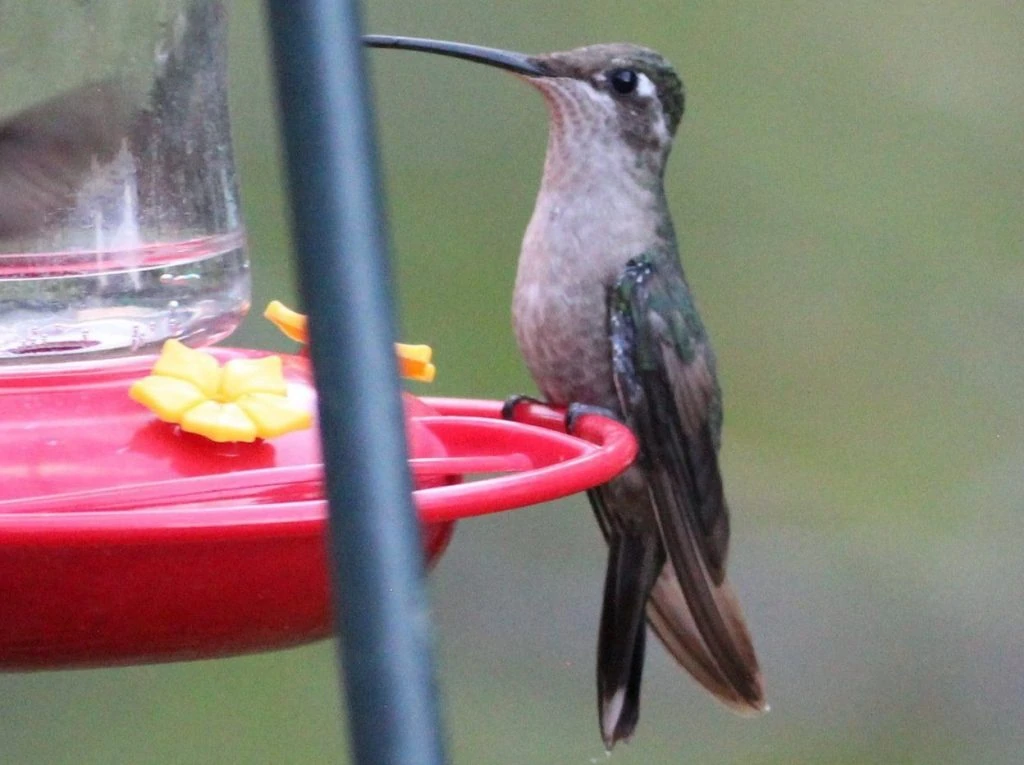
Hummingbirds can travel over 4000 miles in a year, fly at 98 km/h, have a wingbeat of an average of 58 beats per second, and lay an egg the size of a jelly bean!
Tiny bursts of color and speed coupled with magnificent hovering skills make the hummingbird one of my favorite bird species with good reason.
Hummingbirds are the only species of bird that can fly backward, and their closest relative are swifts!
Many Hummingbirds are migratory and spend the winter in Mexico or further south and the summer in the United States and Canada for breeding.
There are 10 species of hummingbirds in Utah that have been spotted. Of these, 5 species are recognized on state checklists as regularly occurring, 5 additional species are considered rare or accidental, and one of these is also regarded as near-threatened.
This guide will help you identify the hummingbird species spotted in Utah according to avibase . The hummingbirds in this list are ordered how frequently they are spotted in the state, from most frequent to least frequent, according to bird watchers’ checklists for the state submitted to ebird .
In Utah, the hummingbirds considered as regularly occurring are Black-chinned Hummingbirds, Broad-tailed Hummingbirds, Rufous Hummingbirds , Calliope Hummingbirds, and Costa’s Hummingbird s.
In summer, the most common species are Black-chinned Hummingbirds and Broad-tailed Hummingbirds .
You can print out a free bird identification photo guide for Utah to help you identify many of the birds that visit your backyard.
10 Species of Hummingbirds in Utah
1. black-chinned hummingbird.
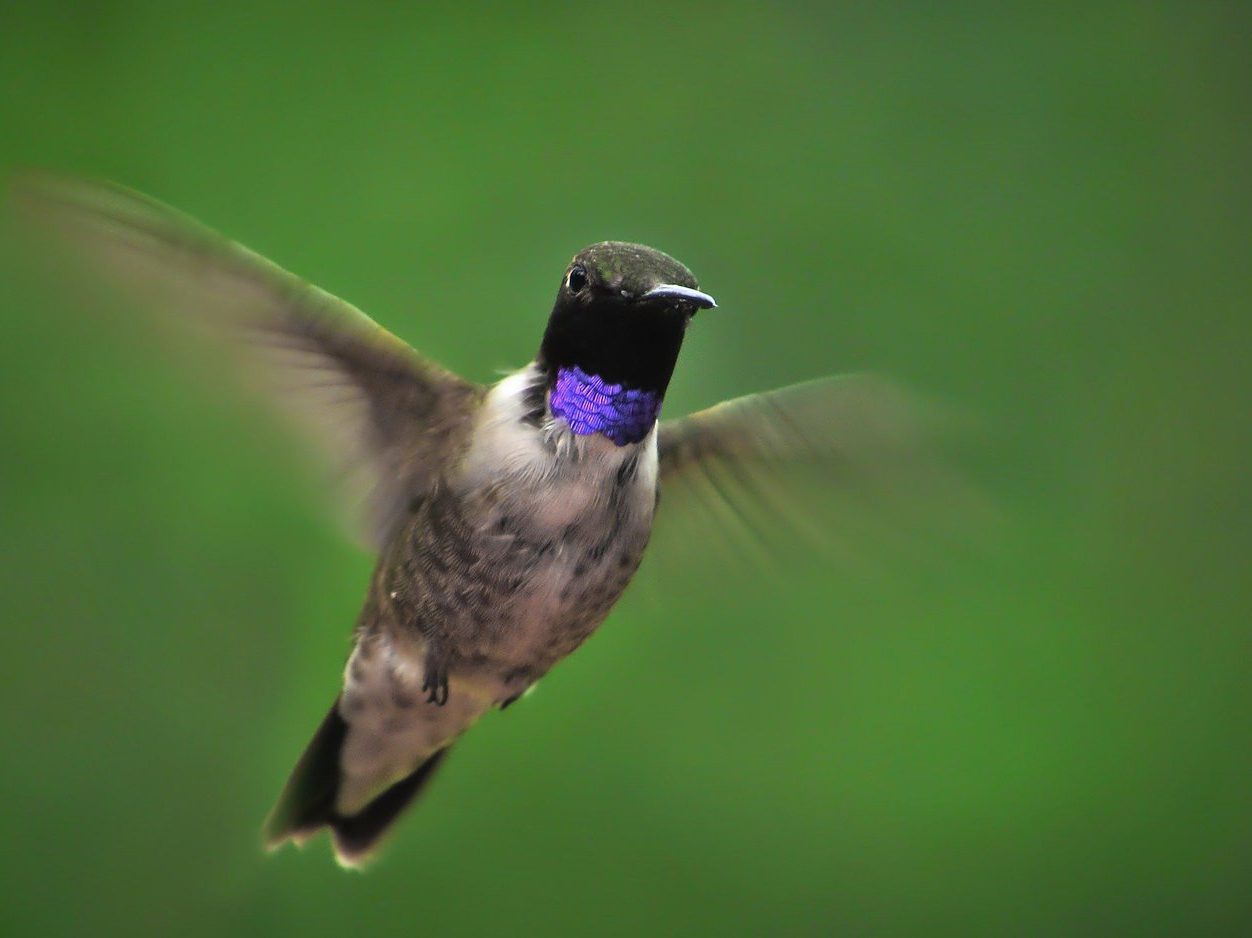
In summer, Black-chinned Hummingbirds are the most frequently spotted hummingbirds in Utah and appear in 20% of checklists. They can be seen in the state during the breeding season, from March to October.
Black-chinned Hummingbirds are dull metallic green on the back and grayish-white underneath. The males have a black throat with a thin iridescent purple base, and the females have a pale throat and white tips on the tail feathers.
- Length : 3.5 in (9 cm)
- Weight : 0.1-0.2 oz (2.3-4.9 g)
- Wingspan : 4.3 in (11 cm)
In summer, black-chinned Hummingbirds breed predominantly inland in western states from British Columbia to Baja California.
After breeding, they may move to higher mountain areas with abundant flowers before migrating to western Mexico, southern California, and the Gulf Coast in the winter. Migration of Black-chinned Hummingbirds usually occurs in March and September.
Black-chinned Hummingbird calls and wingbeat:
They eat nectar, small insects, and spiders, and their tongues can lick 13-17 times per second when feeding on nectar. Nests of Black-chinned Hummingbirds are made of plant down and spider silk to hold them together, and they lay two tiny white eggs that are only 0.6 in (1.3 cm)
Black-chinned Hummingbirds can often be seen sitting at the top of dead trees on tiny bare branches and often return to a favorite perch. They can be found along canyons and rivers or by shady oaks.
2. Broad-tailed Hummingbird
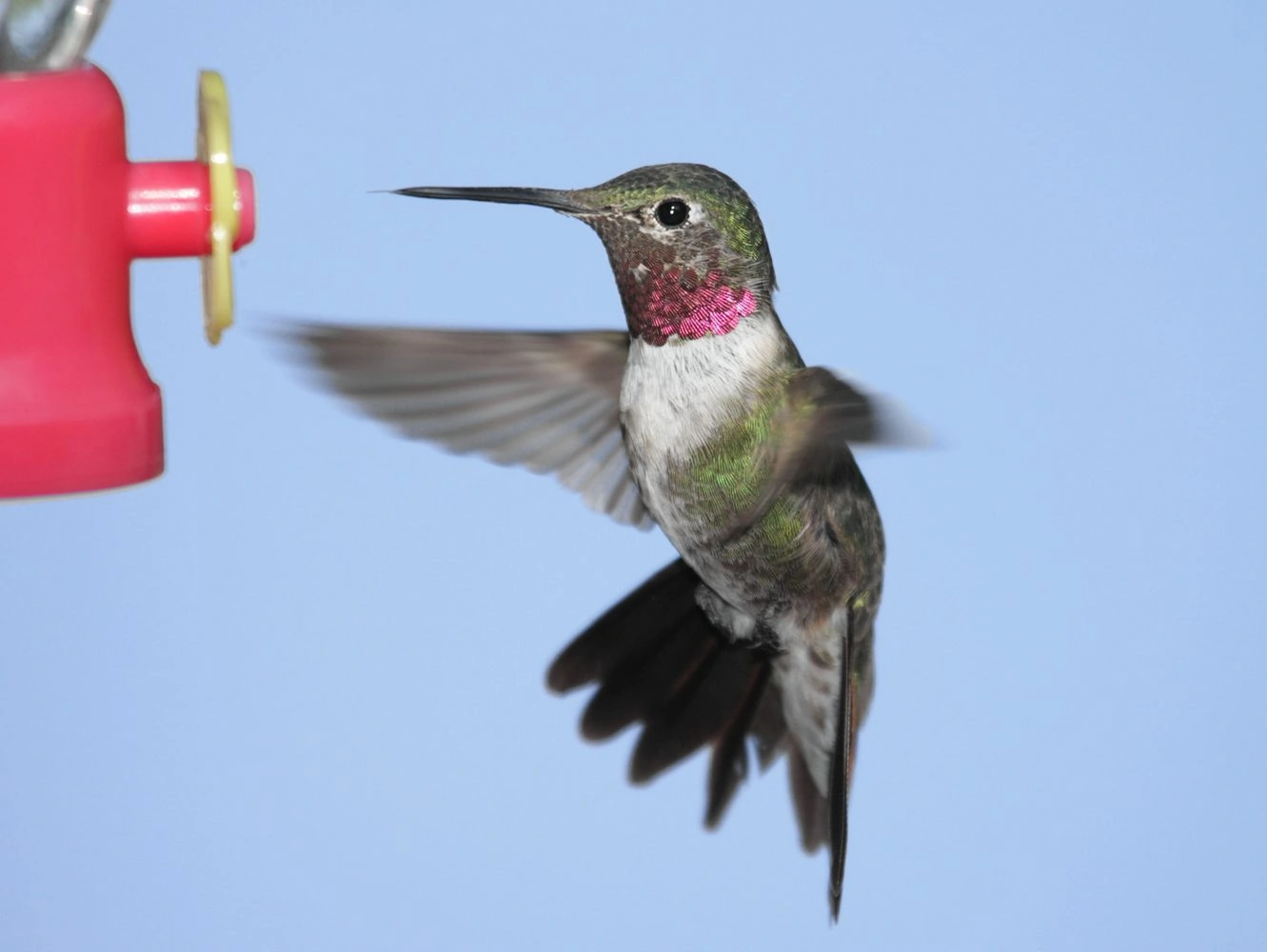
In summer, Broad-tailed Hummingbirds are the second most frequently spotted hummingbirds in Utah and appear in 14% of checklists. They can be spotted in the state during the breeding season, from March to October.
Broad-tailed Hummingbirds live in higher elevations and are iridescent green on the back, brownish in the wings, and white on the chest and into the belly. Males have an iridescent rose throat, females and juveniles have green spots on their throats and cheeks.
- Length : 3.1-3.5 in (8-9 cm)
- Weight : 0.1-0.2 oz (2.8-4.5 g)
Broad-tailed Hummingbirds breed in high meadows and open woodlands between 5,000 – 10,000 feet elevation in the mountainous west, between late May and August between central Idaho, southern Montana, northern Wyoming, and south to California.
Migration south is to southern Mexico for winter, but some Broad-tailed Hummingbirds may stay on the Gulf Coast. Migration of Broad-tailed Hummingbirds occurs in April and again in late August and September.
Due to the cold at higher elevations, the Broad-tailed Hummingbird can slow their heart rate and drop their body temperature to enter a state of torpor.
Nectar from flowers is the usual food of hummingbirds, and Broad-tailed Hummingbirds drink from larkspur, red columbine, sage, scarlet gilia, and they will also come to hummingbird nectar feeders. They supplement their diet with small insects and feed their young on insects.
Broad-tailed Hummingbird nests are usually on evergreen or aspen branches and are made with spider webs and gossamer under overhanging branches for added insulation during cold nights.
3. Rufous Hummingbird
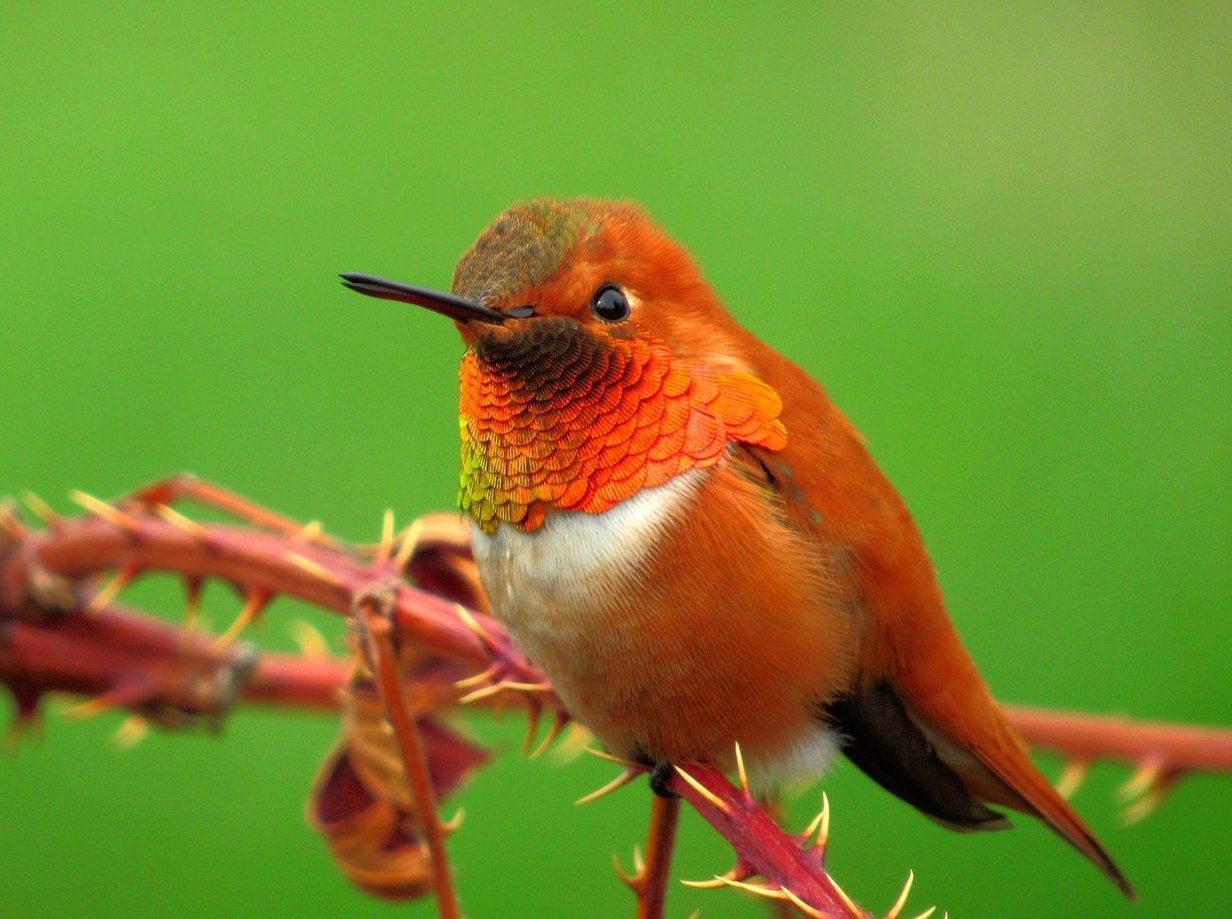
Although considered near-threatened species , Rufous Hummingbirds are the third most frequently spotted hummingbirds in Utah during summer , from April to October, and appear in 2% of checklists.
Rufous Hummingbirds are bright orange on the back and belly, a white patch below the throat, and an iridescent red throat in the males. The females are greenish-brown on the back, and rusty colored on the sides with a whitish belly.
- Length : 2.8-3.5 in (7-9 cm)
- Weight : 0.1-0.2 oz (2-5 g)
Rufous Hummingbirds are one of the longest migrating birds relative to their size, traveling up to 4000 miles each way. In the summer, they breed in northwest Alaska and northwest Canada and migrate down to Mexico and the Gulf Coast for winter.
Migration of Rufous Hummingbirds is north along the Pacific Coast in spring and the Rocky Mountains in late summer and fall. Migration in the spring of Rufous Hummingbirds starts in February, and they usually reach Alaska by mid-April. Migration in the fall is in July and August and ends by October.
A study has shown that Rufous Hummingbirds start their migration earlier and travel north more inland than before.
Rufous Hummingbird numbers have declined by around 60% since the 1970s
Rufous Hummingbirds feed primarily on nectar from colorful tubular flowers and insects such as gnats, midges, and flies. They build a nest high up in trees using soft down from plants and spider webs to hold it together. They lay 2-3 tiny white eggs about 0.5 in (1.3 cm) long. Their habitat is mountain meadows and coniferous forests.
They are very aggressive and chase off any other hummingbirds that may appear, even larger hummingbirds or resident ones during migration. They won’t hang around long during migration but will still chase off most other hummingbirds given a chance.
4. Anna’s Hummingbird
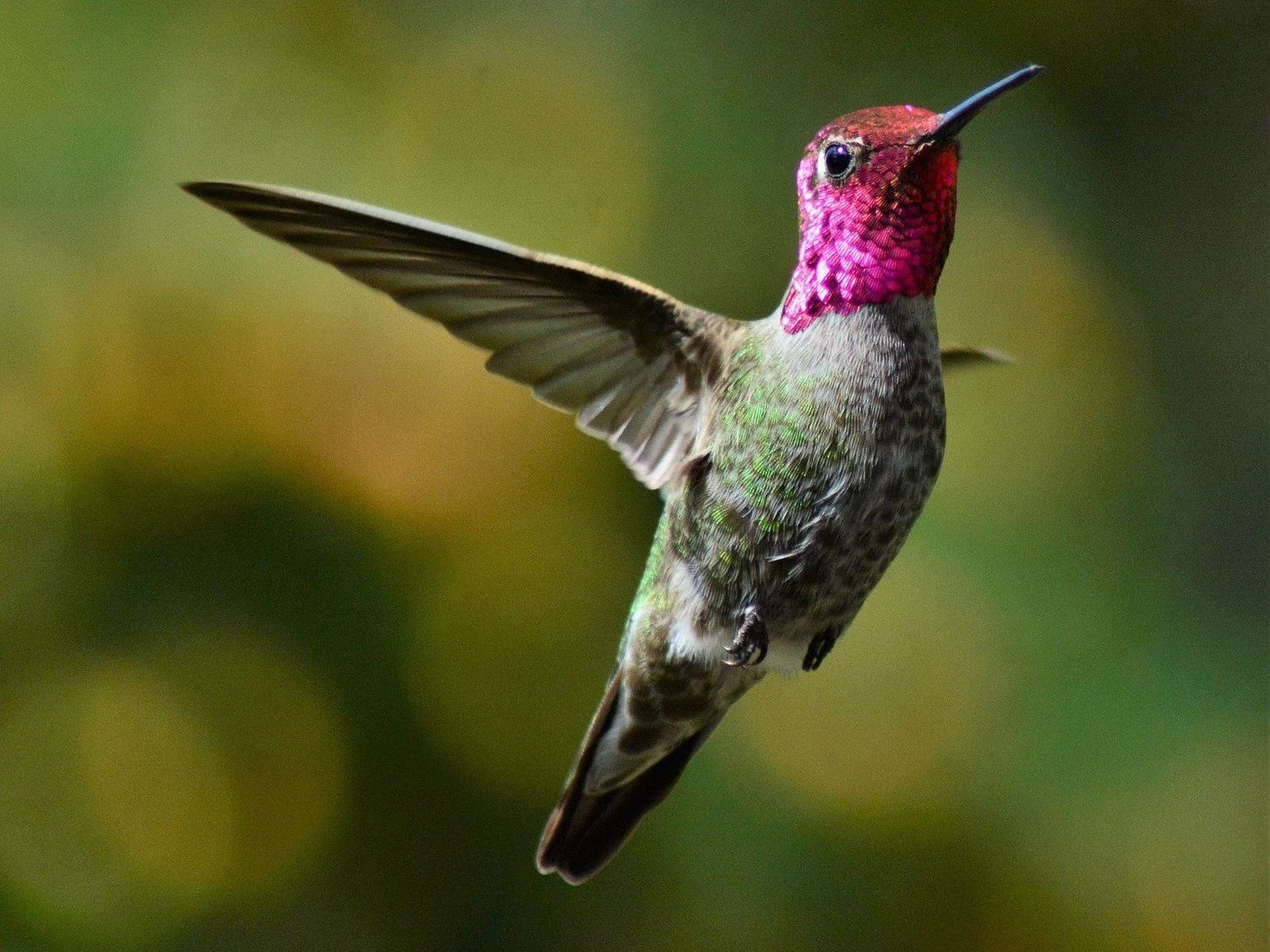
Anna’s Hummingbirds are considered accidental species in Utah but they are the most frequently spotted hummingbirds in winter and appear in 1% of these checklists. They are mostly seen around Salt Lake City and St. George.
Anna’s Hummingbirds are tiny birds that are primarily green and gray. The male’s head and throat are iridescent reddish-pink. The female’s throat is grayish with bits of red spotting.
- Length : 3.9 in (10 cm)
- Weight : 0.1-0.2 oz (3-6 g)
- Wingspan : 4.7 in (12 cm)
Anna’s Hummingbirds are the most common hummingbird along the Pacific Coast and they do not migrate, which is unusual for hummingbirds.
Their range is from British Columbia to Baja California in both summer and winter. However, some birds may move from the far north of their range for winter.
Habitats of Anna’s hummingbirds are often backyards and parks with large colorful blooms and nectar feeders, but they are also found in scrub and savannah.
The diet of Anna’s Hummingbirds includes nectar, tree sap, and small insects and spiders. Nectar sources are Eucalyptus, Nicotiana, Agave, Castilleja, Diplaucus, Ribes, Silena, Arctostaphylos, and nectar feeders.
Anna’s Hummingbird call sounds :
Anna’s Hummingbirds’ nests are high up in trees at around 6 – 20 ft, and they often have 2-3 broods a year, and female hummingbirds do all of the work!
During courtship, they make dramatic dive displays as the males climb up to 130 feet into the air before diving back to the ground with a burst of noise from their tail feathers.
5. Calliope Hummingbird
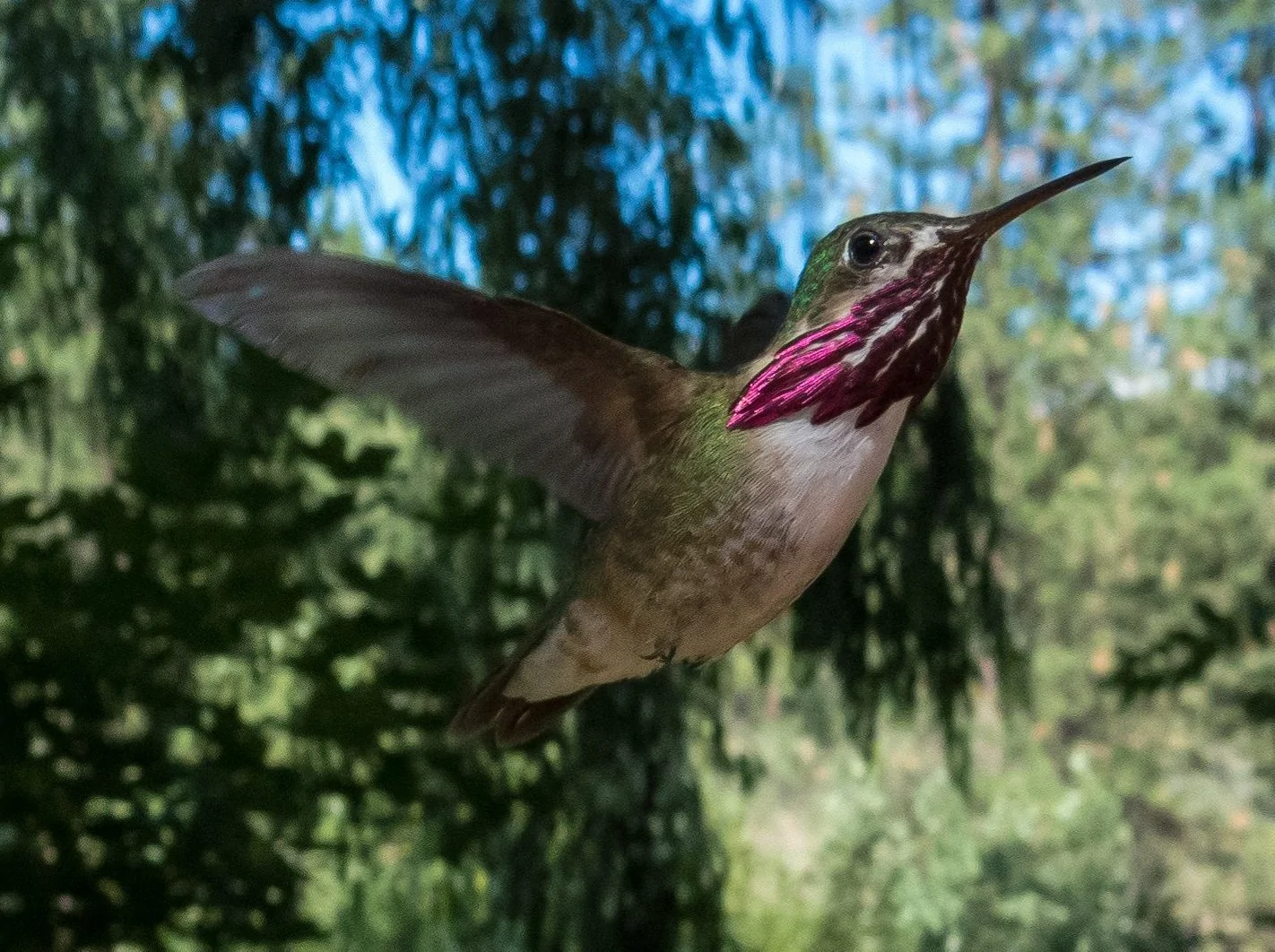
Although not commonly spotted in Utah , Calliope Hummingbirds are recognized as regularly occurring . They are mainly seen in Dixie National Forests and around Salt Lake City from April to September.
The tiny ping ball-sized Calliope Hummingbird is the smallest bird in the United States but still manages to fly more than 5000 miles each year all the way from Mexico up as far as Canada and back.
They also punch above their weight when it comes to defending their territory and even chase Red-tailed Hawks.
Male Calliope Hummingbirds have bright magenta throats (known as the gorget), glossy green backs and flanks, and a dark tail. Females lack the iridescent throats and are more pinkish-white underneath rather than white in the males.
- Length : 3.1-3.5 in (8-9 cm)3
- Weight : 0.1-0.1 oz (2.3-3.4 g)
- Wingspan : 4.1-4.3 in (10.5-11 cm)
Calliope Hummingbirds’ spring migration is to the Rocky Mountains along the Pacific Coast to breeding areas in California, Colorado, and up to northwestern states, Alberta, British Columbia, and Vancouver Island. They start migration relatively early in February to arrive from Mid-April to early May as far north as Canada.
Fall migration is by the Rocky Mountains to wintering grounds in southwestern Mexico, but also more recently to the Gulf Coast in late August and September.
Nests are usually on evergreen trees, and they may reuse them or build on top of an old nest.
6. Costa’s Hummingbird
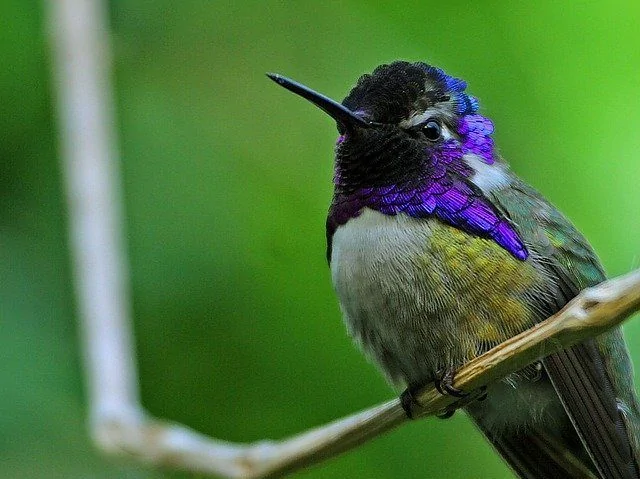
Costa’s Hummingbirds are rarely spotted in Utah, but they are recognized as regularly occurring. They are mainly seen in the southwest of the state, like in Beaver Dam Wash National Conservation Area, St. George, and Zion National Park from late March to May.
Costa’s Hummingbirds are predominantly desert hummingbirds with striking iridescent purple throat patches that flare out and a purple crown. Their backs are green, and their bellies are white with green coloring on the sides. Female Costa’s Hummingbirds lack the purple color and are more white on the belly.
- Length : 3.5 in ( 7.6 – 8.8 cm)
- Weight : 0.1-0.1 oz (2-3 g)
Costa’s Hummingbirds are residents of Baja California, Southern California, and southwestern Arizona. They also migrate between the Pacific Coast of Mexico in winter and up into Arizona, the southern edges of Nevada and Utah, and California for breeding.
Desert scrub, chaparral, and deciduous forest provide the habitat of Costa’s Hummingbirds, and they visit many different species of plants. Nests are built quite low at three to seven feet above the ground in shrubs, and they may have up to two broods in a year.
7. Broad-billed Hummingbird
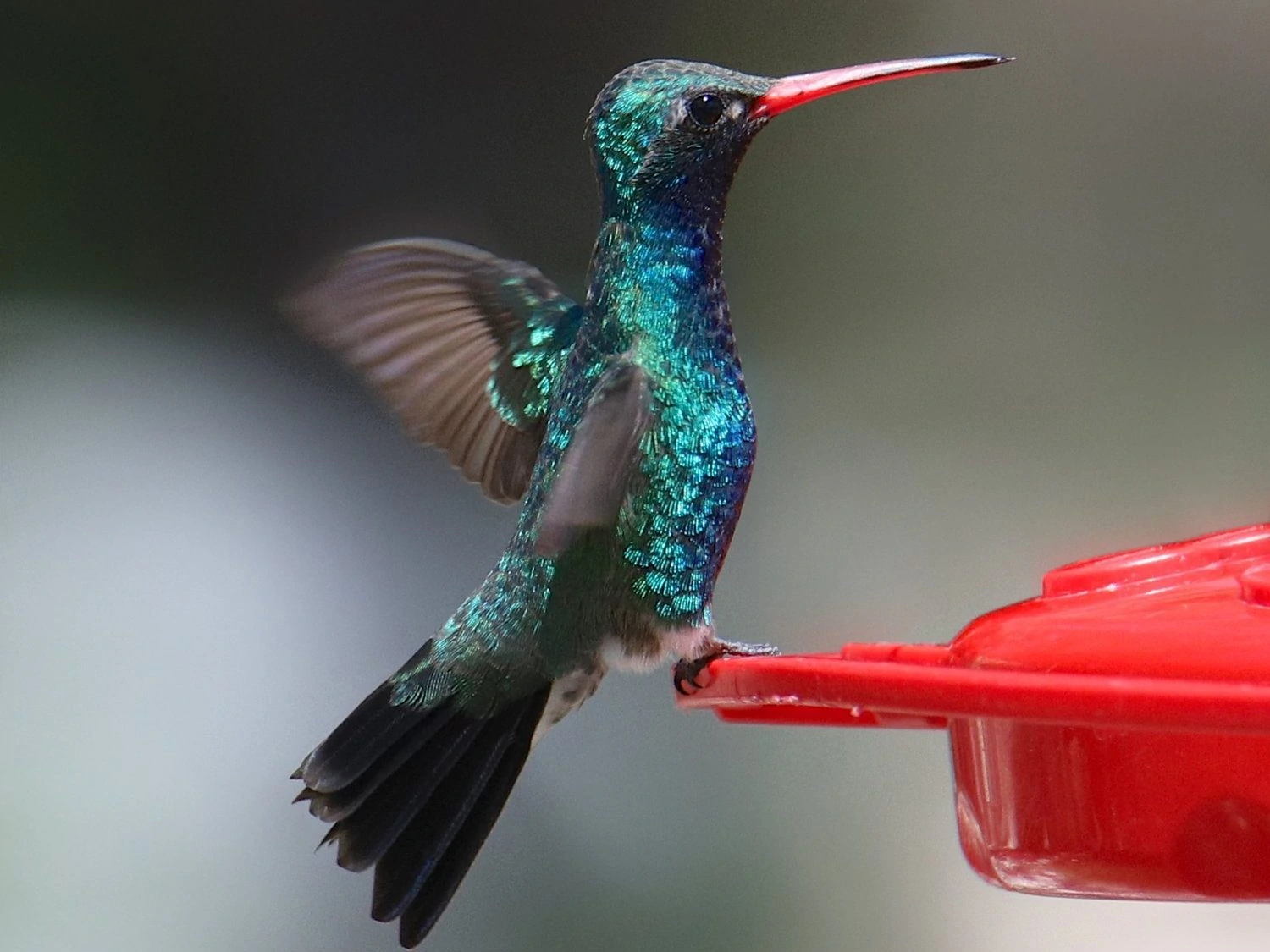
Although considered an accidental species in Utah, Broad-billed Hummingbirds were last spotted in Castle Valley in 2020.
Broad-billed Hummingbirds are brilliantly colored, even among hummingbirds. The males are rich metallic green all over with a blue throat that extends down the breast. Females have a pale belly, and both males and females have red beaks that are black-tipped and wide near their heads.
- Length : 3.1 – 3.9 in (8-10 cm)
- Weight : 0.1-0.1 oz (3-4 g)
Broad-billed Hummingbirds are resident all year in central Mexico and the Pacific Coast of Mexico. Some birds migrate north into mountain canyons in southern Arizona and New Mexico for breeding between March and September, and a few remain all year near the Mexican border.
Canyon streams and mountain meadows provide the ideal foraging areas for Broad-billed Hummingbirds, but they will also visit backyard feeders. Nests are built quite low to the ground, at about 3 feet up, near streams.
8. Ruby-throated Hummingbird
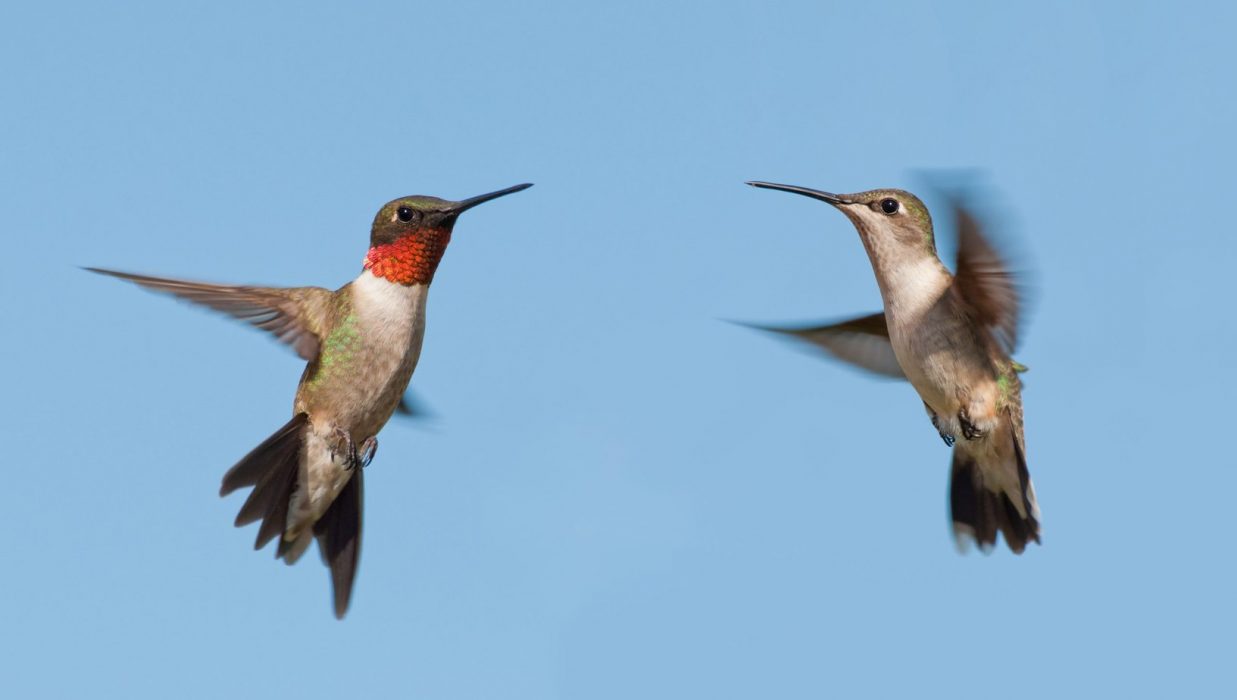
Ruby-throated Hummingbirds are considered accidental or rare species in Utah, but there were a couple of sightings in Ogden in 2020.
The Ruby-throated Hummingbirds are bright green on the back and crown, with a gray-white underside and the males have an iridescent red throat.
Female Ruby-throated Hummingbirds are green on the back and white underneath with brownish crowns and sides.
- Weight : 0.1-0.2 oz (2-6 g)
- Wingspan : 3.1-4.3 in (8-11 cm)
The Ruby-throated Hummingbird is the only breeding hummingbird in eastern North America. They then migrate further south to Central America for winter. Some migrate over the Gulf of Mexico, or some migrate through Texas around the coast.
Ruby-throated hummingbirds start arriving in the United States in February and may not arrive in northern states and Canada until May for breeding. In spring, males usually arrive first up to one or two weeks before the females.
In the fall, Ruby-throated Hummingbirds migrate south in August and September and gather in September along the Gulf Coast of Texas before making the final push south for winter.
These tiny birds zip from one nectar source to the next or catch insects in midair or from spider webs. They occasionally stop on a small twig, but their legs are so short they cannot walk, only shuffle along a perch.
In summer, flowering gardens or woodland edges are the best places to find them. They are also common in towns, especially at nectar feeders.
Ruby-throated Hummingbird calls and wingbeat:
Male Ruby-throated Hummingbirds can be aggressive in their defense of flowers and feeders. Males do not stick around long after mating and may migrate by early August.
Ruby-throated females build nests on thin branches and make them out of thistle or dandelion down held together with spider silk. They lay 1-3 tiny eggs measuring only 0.6 in (1.3 cm)
9. Rivoli’s Hummingbird
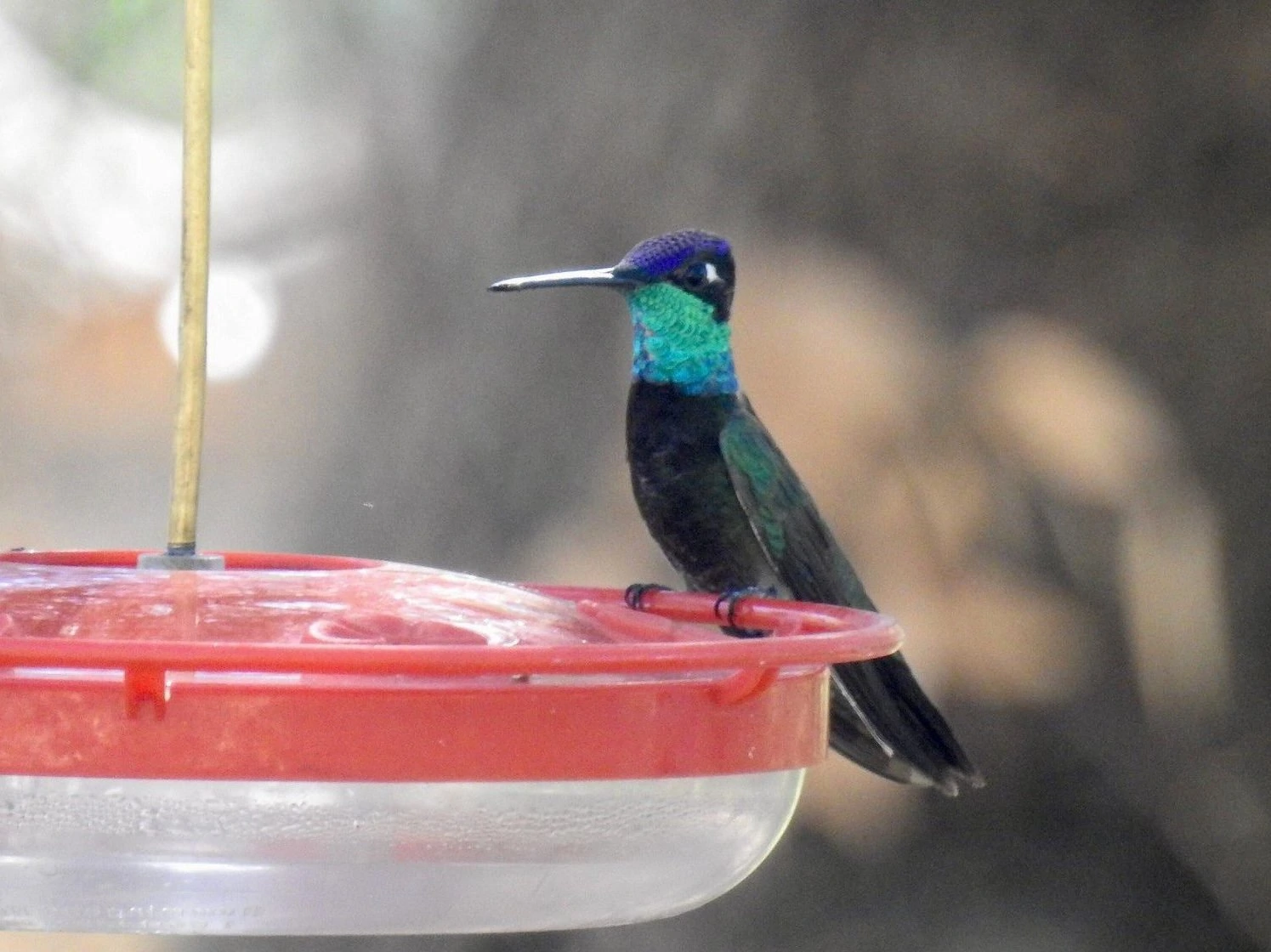
Rivoli’s Hummingbirds are considered an accidental species in Utah. They are extremely rarely spotted in the state. The last time was around Stout Canyon Road back in 2001.
Rivoli’s Hummingbirds are large hummingbirds with more striking coloring than most hummingbirds as they have an iridescent purple crown as well as the more usual iridescent throat in the males, which is emerald green. Males are dark green, and the females are green on the back and grayish underneath.
- Length : 4.3-5.5 in (11-14 cm)
- Weight : 0.3-0.3 oz (7-8 g)
Rivoli’s Hummingbirds are resident in Mexico and Central America, but some do migrate north into southern Arizona and New Mexico, and southwestern Texas. They can be found in pine-oak forests in mountainous regions but will visit feeders in their range. They build nests relatively high up.
10. Allen’s Hummingbird
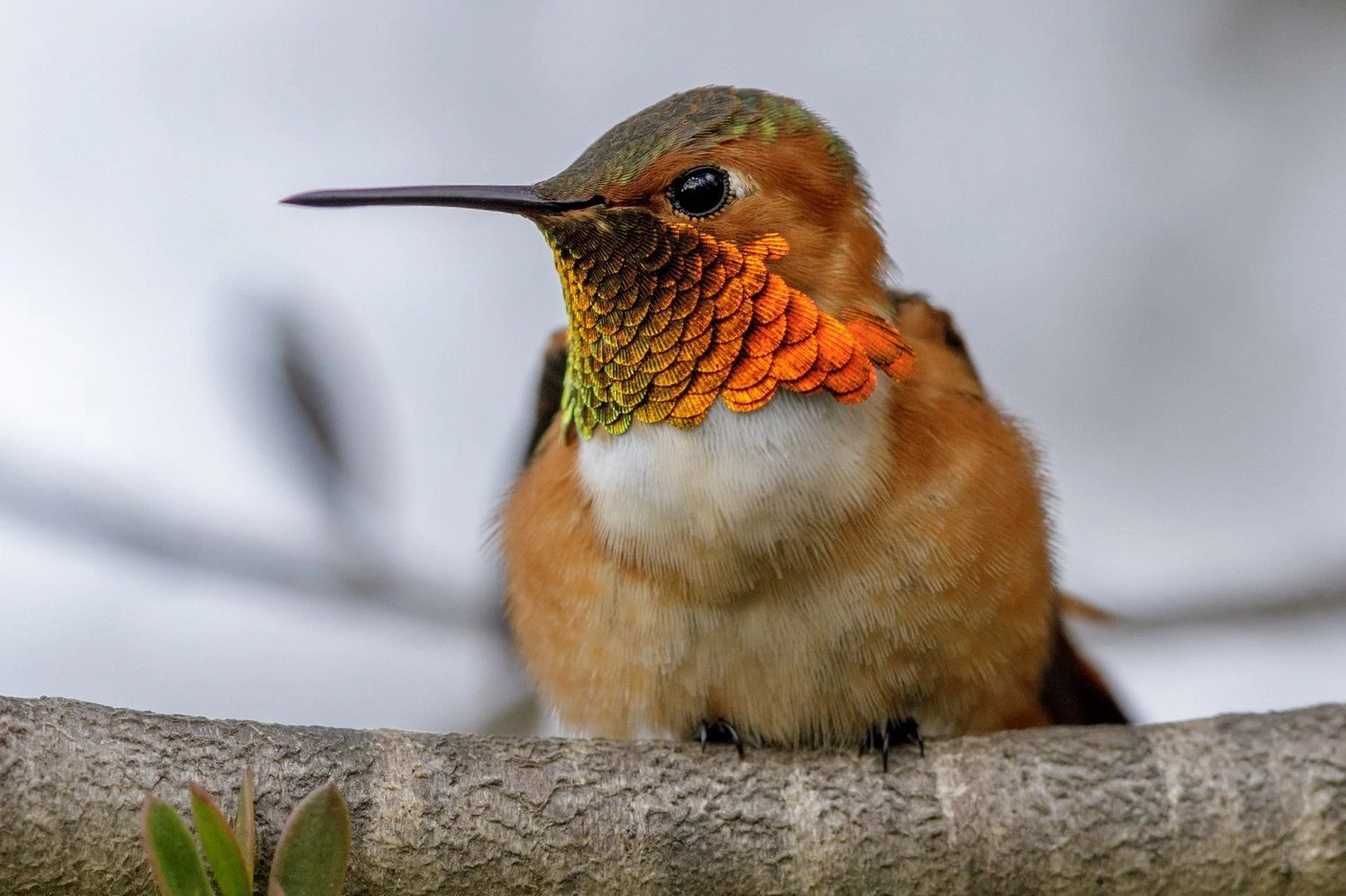
Allen’s Hummingbirds are extremely rare birds to see in Utah, but they have been accepted by the Utah Birds Records Committee , with some recorded sightings in the state.
Allen’s Hummingbirds look very similar to Rufous Hummingbirds, so it’s hard to tell them apart in the narrow band of coastal forest and scrub they inhabit between California and Oregon.
Male Allen’s Hummingbirds have iridescent reddish-orange throats and orange bellies, tails, and eye patches. Both males and females have long straight bills and coppery-green backs, but the females lack the bright throat coloring.
- Weight : 0.1-0.1 oz (2-4 g)
The difference between Allen’s and Rufous Hummingbirds is the narrow outer tail feathers in Allen’s Hummingbird.
Allen’s Hummingbirds build nests near shady streams and have up to 3 broods a year. They spend winter in Mexico and migrate as early as January up to the Pacific Coast in California and Oregon, but they are most common between March and July. Some remain residents all year in central Mexico and around Los Angeles.
How Frequently Hummingbirds are Spotted in Utah in Summer and Winter
Checklists for the state are a great resource to find out which birds are commonly spotted. These lists show which hummingbirds are most commonly recorded on checklists for Utah on ebird in summer and winter.
Hummingbirds in Utah in Summer:
Black-chinned Hummingbird 20.4% Broad-tailed Hummingbird 14.8% Rufous Hummingbird 2.0% Calliope Hummingbird 0.6% Anna’s Hummingbird 0.4% Costa’s Hummingbird 0.3% Ruby-throated Hummingbird <0.1% Broad-billed Hummingbird <0.1% Rivoli’s Hummingbird <0.1%
Hummingbirds in Utah in Winter:
Anna’s Hummingbird 1.2% Costa’s Hummingbird 0.1% Broad-billed Hummingbird <0.1%
How to Attract the Hummingbirds of Utah to Your Backyard
If you would like to attract more hummingbirds to your yard, here are some tips:
- Provide more hummingbird feeders to fill with homemade nectar and spread them around your yard to create more territories.
- Ensure you clean and change the hummingbird nectar regularly to stop diseases spreading. You can either buy nectar or make your own, but don’t use any with red dye.
- Provide a water feature such as a birdbath fountain or stream. Ensure that the water is clean and not stagnant
- Grow native plants that will provide food such as salvias, fuschias, trumpet creeper, lupin, columbine, bee balms, and foxgloves
- Don’t use pesticides and herbicides as these may be toxic to birds.
- Provide small perches of thin branches, bare of leaves, for hummingbirds to rest.
Related Articles:
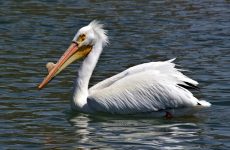
20 Largest Birds In Utah (By Weight, Length, Wingspan)
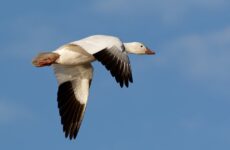
13 White Birds In Utah (ID, Photo, Call Guide)
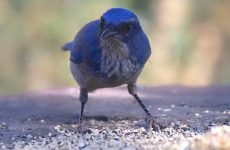
9 Types Of Crows And Jays In Utah (And Their Calls)
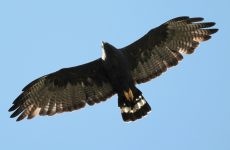
All The Birds Of Prey In Utah And Their Calls
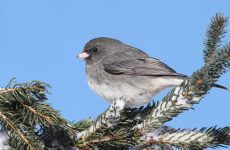
25 Winter Birds Utah (Out Birding)
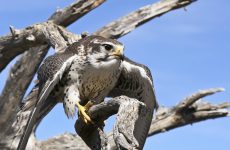
All The Falcons In Utah And Their Calls (ID, Photos, When To Spot)
Newsletter Signup
Signup for regular news all about birdwatching, bird identification and fun facts
You have successfully joined our subscriber list.
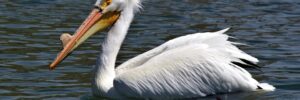
Animal Diversity Web
- About Animal Names
- Educational Resources
- Special Collections
- Browse Animalia
More Information
Additional information.
- Encyclopedia of Life
Trochilidae hummingbirds

Hummingbirds belong to the order Apodiformes , meaning, "unfooted birds." There are three families in this order: Trochilidae (hummingbirds), Hemiprocnidae (tree swifts), and Apodidae (swifts). The family Trochilidae belongs to its own Suborder, Trochili . Although the number of genera and species in this group changes continually, currently there are 102 recognized genera and 328 species of hummingbirds. The hummingbird family is divided into two sub-families: Phaethornithinae (hermits) composed of 34 species and a larger group, Trochilinae (trochilines or "typical" hummingbirds), with 294 species.
Hummingbirds feed primarily on the nectar of flowers and supplement their diet with small insects. They have evolved unique characteristics such as narrow elongated beaks, extendable tongues and hovering flight, all of which allow them to exploit nectar resources.
Most hummingbird species are polygynous (males mate with more than one female) and are sexually dimorphic (sexes do not look alike); males (especially trochilines) often have bright iridescent feathers while females have more cryptic coloration. Some male hummingbirds have elaborate ornamentation such as elongated tail feathers and iridescent crests. Male hermits display together in large groups called leks while trochilines are mainly territorial; their courtship often involves dramatic aerial displays.
Known for their small size (the smallest species of hummingbird weighs 2 g), rapid wing movements and heartbeat, hummingbirds can compensate for their high energetic requirements by going into torpor during cold nights. This is especially important for those species found at high elevation where nighttime temperatures can dip below freezing.
Hummingbirds are found in a variety of habitats and while their range includes much of the New World, most hummingbird species are Neotropical. ( Campbell and Lack, 1985 ; ; Gill, 1995 ; Schuchmann, 1999 )
Geographic Range
Hummingbirds are found only in the New World in the Nearctic and Neotropics. Their range extends from Alaska to Labrador in the North to Tierra del Fuego in the south and from Barbados to the Juan Fernandes islands. Most species are tropical and sub-tropical and live between 10 degrees N and 25 degrees S lattitude. More than half of all species of hummingbird are found in Brazil and Ecuador. ( Campbell and Lack, 1985 ; ; Schuchmann, 1999 ; Tyrrell and Tyrell, 1985 )
- Biogeographic Regions
Hummingbirds feed and nest in a wide variety of terrestrial habitats, both temperate and tropical. The main habitat requirement for hummingbirds is a large number of nectar producing flowers. This requirement is satisfied in a number of different habitats: arid scrub, desert oasis, coastal lowland, tropical rainforest, Neararctic pine forests, and alpine tundra. Hummingbirds can be found in habitats from coastal areas at sea level to mountainous areas at an elevation of 5000 m.
Due to the prevalence of hummingbird feeders and cultivated gardens, hummingbirds can sometimes be found in urban and suburban areas with few natural food sources. There are also some agricultural crops, such as banana and coffee that can support hummingbirds. ( Campbell and Lack, 1985 ; ; Sargent and Sargent, 2001 ; Schuchmann, 1999 ; )
- Habitat Regions
- terrestrial
- Terrestrial Biomes
- desert or dune
- scrub forest
- Other Habitat Features
- agricultural
Physical Description
Hummingbirds are known for their small size, long, thin bills, and amazing agility in flight. The smallest hummingbirds, reddish hermits ( Phaethornis ruber ) and bee hummingbirds ( Mellisuga helenae ) weigh less than 2 g while giant hummingbirds ( Patagona gigas ) weigh 19 to 21 g. Most species weigh 2.5 to 6.5 g and are 6 to 12 cm in length. Their bills are a variety of shapes; bill length and shape are often good indicators of the types of flowers each species feeds on. Hummingbirds have extendable bifurcated tongues that are used to extract nectar from flowers.
As the name of their order, Apodiformes (“unfooted birds”) suggests, hummingbirds have characteristically small feet. They are unable to walk on the ground and will fly rather than walk in order to shift on a perch.
Hummingbirds have many skeletal and flight muscle adaptations that allow for hovering and high maneuverability in flight. They are the only birds that truly hover and are capable of both forward and backward flight. The characteristic humming sound they make in flight is caused by modified outer primary feathers and is the basis for their common name. Hummingbirds can achieve a forward speed of 45 km per hour and their wingbeat ranges from 70 to 80 beats per second in smaller birds to 10 to 15 beats per second in giant hummingbirds. Their heartbeat is equally rapid ranging from 500 to 600 beats per minute while resting to over 1000 beats per minute when active.
There are two sub-families of hummingbird, hermits ( Phaethornithinae ) and “typical” hummingbirds or trochilines ( Trochilinae ). Hermits generally have brownish, grayish and reddish colors and no iridescence. Trochilines often have iridescent feathers of metallic red, orange, green and blue. Iridescence is seen most in male hummingbirds and occurs on the head, upperparts and underparts. Some males also have elegant ornamentation such as bright throat gorgets, crests and elongated tail feathers.
Hummingbirds are sexually dimorphic. Females can be bigger than males, but males are usually more colorful and can have additional adornments. Female hummingbirds have more cryptic coloration than males, most likely so that they do not attract predators to the nest when incubating and feeding chicks. The plumage of immature birds is usually similar to that of females. ( Campbell and Lack, 1985 ; ; Gill, 1995 ; Howell, 2002 ; Johnsgard, 1997 ; Sargent and Sargent, 2001 ; Schuchmann, 1999 ; ; Tyrrell and Tyrell, 1985 )
- Other Physical Features
- endothermic
- bilateral symmetry
- Sexual Dimorphism
- female larger
- sexes colored or patterned differently
- male more colorful
- ornamentation

Reproduction
Hummingbirds are polygynous; males interact with females only to breed and provide no parental care. Females are responsible for nest building, incubation and post-hatching parental care. Males attract mates using song, iridescent plumage and dramatic display flights. Depending on the species, males display at lekking grounds, defended territories, traditional display grounds, or singing posts. ( Campbell and Lack, 1985 ; ; Howell, 2002 ; Schuchmann, 1999 )
- Mating System
Hummingbirds breed during the season with peak nectar availability. Most hummingbirds build cup nests, but a few build domed or semi-domed nests that provide more protection than an open cup nest. Nest height ranges from a few centimeters above the ground to 10 to 30 meters. Nests are camouflaged with lichen, moss, dead leaves, bark, etc. and are held together with spider webs. They are sometimes lined with feathers, fur, hair, or plant down. Nests take 5 to 10 days to build and are often re-used year to year.
Clutch size is two and eggs are white, non-glossy and an elliptical oval shape. Because some species of hermits will lay eggs in another female’s nest, clutches of more than two can sometimes be found. There is a 48-hour interval between egg laying. The size of hummingbird eggs range from 8 by 11 mm in bee hummingbirds ( Mellisuga helenae ) to 12 by 20 mm in giant hummingbirds ( Patagona gigas ). The average weight of an egg is 0.4 to 1.4 g. Incubation usually lasts 16 to 19 days. If females begin incubating after the first egg is laid, hatching of the two eggs can occur 48 hours apart. If she waits until the second egg is laid, hatching occurs synchronously. Nestling period is 23 to 26 days; hatchlings are altricial with almost no feathers and eyes closed. Females brood young for 7 to 12 days, at which point the young are able to control their own body temperature. Fledglings continue to be fed by the female for 18 to 25 days after they have left the nest.
Female hummingbirds can have two broods per year when conditions permit and will re-nest if a brood is lost. Most nest failure is due to depredation. ( Campbell and Lack, 1985 ; ; Johnsgard, 1997 ; Schuchmann, 1999 )
- Key Reproductive Features
- iteroparous
- seasonal breeding
- gonochoric/gonochoristic/dioecious (sexes separate)
Only female hummingbirds are involved in parental care; they must incubate eggs, brood young hatchlings, and feed the chicks as nestlings and fledglings. Hummingbird chicks are altricial and stay in the nest for 23 to 26 days. When they first hatch, young hummingbirds have few feathers and cannot thermoregulate. The female must brood the young for 7 to 12 days until they can maintain their body temperature. Females feed nestlings nectar and arthropods approximately twice every hour. Fledglings are fed by the female for 18 to 25 days and gradually learn to forage by themselves. ( Campbell and Lack, 1985 ; ; Schuchmann, 1999 )
- Parental Investment
- female parental care
Lifespan/Longevity
Both male and female hummingbirds usually live from 6 to 12 years and have been known to survive up to 17 years in captivity. It is difficult to estimate annual survival, but for North American species it is thought to be 30 to 45 percent. (; Sargent and Sargent, 2001 ; Schuchmann, 1999 ; ; Stokes and Stokes, 1989 ; Tyrrell and Tyrell, 1985 )
Hummingbirds are solitary animals. They are polygynous and males provide no parental care. Males of many species of hummingbird are territorial and the territories, which are usually centered around a food source, are aggressively defended by their owners. Territorial individuals will perch in a conspicuous spot (often the top of a tree) and watch for intruders. If an intruder is spotted the territory holder will give warning calls, perform hovering displays while flashing iridescent feathers and if necessary, chase off the intruder. Occasionally agonistic interactions will escalate and the birds will attack each other, sometimes using their beaks as weapons. When food is scarce, territory owners will use less energetically expensive behaviors to exclude intruders. Females may also set up territories surrounding nest sites. Those hummingbirds that are not territorial are mainly trap-line feeders; they will move throughout an area and feed on numerous patches of flowers.
Hermits usually form leks and congregate on traditional lekking grounds, where females visit to choose a mate. Male hummingbirds are known for their spectacular display flights that they perform in front of females during courtship and in view of intruding males during agonistic interactions. During a display flight, a male hummingbird can ascend up to a height of 30 m or more, and will dive toward the female or intruding male (often coming within centimeters of the recipient of the display), chipping at the bottom of the dive before ascending again.
Because of their high metabolic rate and the cost of their active flight, hummingbirds spend on average 70% of their time perched (often preening). They are very curious and will investigate brightly colored objects as potential food sources. They are diurnal and forage throughout the day, with peak activity at dawn and dusk.
In order to save energy during cold nights, hummingbirds will go into torpor. During torpor their body temperature decreases 20 to 30 degrees, their heartbeat can go below 50 beats per minute and their breathing becomes irregular. Most bird species are too large to use torpor to save energy since it would take too long and use too much energy to warm back up. It can take hummingbirds as long as an hour to come out of torpor, and if they are disturbed they cannot immediately resume normal activity.
Most tropical hummingbird species do not migrate but some will change elevation in response to changing temperatures or seasons. North American hummingbirds migrate and may fly distances of more than 5,000 km round trip. Males are the first to arrive at breeding and wintering grounds and are followed by females and juveniles. Because of the energetic costs of flight some hummingbirds must increase their body weight by 50% before beginning migration. ( Campbell and Lack, 1985 ; ; Gill, 1995 ; Johnsgard, 1997 ; Schuchmann, 1999 ; Skutch and Singer, 1973 ; Tyrrell and Tyrell, 1985 )
- Key Behaviors
- daily torpor
- territorial
Communication and Perception
Both male and female hummingbirds have species-specific calls. Calls are usually short, high-pitched chips but some species have more drawn-out, musical songs. Singing is used both to attract mates and deter intruders. The humming noise made by wings during flight may also be a form of communication, especially in dive displays. Nestlings in domed or semi-domed nests will make begging calls but those in open cup nests will not. Fledglings make contact calls to communicate with their mothers when they are out of sight and begging calls when they are close by. Alarm calls may also be given when predators are nearby.
Hummingbirds, like most other birds do not have a well-developed sense of smell. They have color vision and unlike most vertebrates, are sensitive to ultra-violet light between 325 to 360 nanometers. Ultra-violet perception may help the birds find food since some flowers have ultra-violet color patterns. Male coloration is a cue used by females and conspecific competitors to assess dominance, quality and species identity. ( Campbell and Lack, 1985 ; ; Howell, 2002 ; Johnsgard, 1997 ; Schuchmann, 1999 )
- Communication Channels
- Perception Channels
- ultraviolet
Food Habits
Hummingbirds are nectivores and insectivores; approximately 90% of their diet comes from nectar and 10% from arthropods (flies ( Diptera ), wasps ( Hymenoptera ), spiders ( Araneae ), beetles ( Coleoptera ), and ants ( Hymenoptera )). Thin, elongated hummingbird bills are well adapted to exploit nectar sources. Hummingbird pollinated flowers are usually brightly colored, scentless and have long, tubular corollas. The shape of a hummingbird’s bill determines the species of flower it can feed on. In fact, co-evolution of flower shape and bill shape is a well-studied phenomenon. Hummingbirds have also developed specialized flight structures that allow them to hover in front of flowers while feeding. Without the ability to hover, hummingbirds would not be able to obtain nectar from flowers. In addition, hummingbirds have specialized, bifurcated tongues that they can extend to reach nectar from within a flower. They use capillary action to draw the nectar along their tongue.
Because hummingbirds have a high basal metabolic rate, they can drink their body mass in nectar in less than a day. They get some amino acids from pollen and protein from insects (which they catch by hawking or hover-gleaning). When nectar resources are scarce, hummingbirds will also feed on sap from holes in trees made by sapsuckers ( Sphyrapicus ).
Co-existing species of hummingbirds will specialize on certain flowers or subdivide the habitat. They will either defend nectar resources on a territory or move between patches of flower-rich areas, a behavior called traplining. ( Campbell and Lack, 1985 ; ; Howell, 2002 ; Schuchmann, 1999 ; Skutch and Singer, 1973 )
- Primary Diet
- insectivore
- eats non-insect arthropods
- nectarivore
Adult hummingbirds have few predators. Known predators include snakes ( Serpentes ), forest falcons ( Micrastur , that catch hermits during lekking), and pygmy-owls ( Glaucidium ). Nest predators are the biggest threat to hummingbirds. These include jays ( Corvidae ), toucans ( Ramphastidae ), and some bats ( Micro-chiroptera ).
Female hummingbirds have more cryptic coloration than male hummingbirds. This is thought to be an adaptation that allows the females to be more camouflaged and avoid attracting predators when incubating. Females will fly to their nests in zigzags or semi-circles to avoid leading a predator directly to the nest. Hummingbirds have also been seen mobbing predators. ( Campbell and Lack, 1985 ; Skutch and Singer, 1973 )
- Anti-predator Adaptations
- snakes ( Serpentes )
- forest falcons ( Micrastur )
- pygmy-owls ( Glaucidium )
- jays ( Corvidae )
- toucans ( Ramphastidae )
- bats ( Microchiroptera )
Ecosystem Roles
Many species of plants rely on hummingbirds for pollination. For some species, hummingbirds are their sole pollinators. In Brazil alone, hummingbirds pollinate 58 different plant species.
Hummingbirds often pick up nectar mites ( Acari ) when they visit flowers. The mites climb onto the hummingbird’s bill and into the nostrils. Here they are transported from flower to flower. The mites do not harm the birds; they reproduce on the plants and eat pollen and nectar. At least forty species of mites have been described. ( Campbell and Lack, 1985 ; Grant and Grant, 1968 ; Howell, 2002 ; Stokes and Stokes, 1989 )
- Ecosystem Impact
- nectar mites ( Acari )
Economic Importance for Humans: Positive
In the past, hummingbirds were actively hunted for feathers that were used to make jewelry and adorn clothing. They were also captured for human amusement in zoos and private collections. Hummingbirds are still sold in markets as aphrodisiacs; although there is no scientific evidence that they work.
Beyond the ecosystem services hummingbirds provide (pollination of a wide variety of plant species), perhaps their biggest economic influence can be seen in the market for hummingbird feeders and eco-tourism. (; Schuchmann, 1999 ; Tyrrell and Tyrell, 1985 )
- Positive Impacts
- body parts are source of valuable material
- source of medicine or drug
- pollinates crops
Economic Importance for Humans: Negative
There are no known adverse affects of hummingbirds on humans.
Conservation Status
Two species of hummingbird are known to be extinct: Brace’s emerald ( Chlorostilbon bracei ) and Gould’s emerald ( Chlorostilbon elegans ). There are 9 species listed as critically endangered by the IUCN, 11 listed as endangered and 9 listed as vulnerable. Major threats to hummingbirds are habitat loss, degradation, and fragmentation. Most of the North American species are protected under the Migratory Bird Treaty Act. No hummingbirds are listed by ESA, but almost all, if not all are listed by CITES.
Habitat destruction in the tropics does not threaten hummingbirds as much as it does some other Neotropical species. Hummingbirds can usually find nesting habitat even in human modified landscapes; cleared areas may still produce flowering plants and some plantations (banana and coffee) can support hummingbirds. Feeders and garden flowers have also allowed population and range increases in some North American species. ( "UNEP-WCMC Species Database: CITES-Listed Species", 2003 ; ; IUCN, 2002 ; Sargent and Sargent, 2001 ; Schuchmann, 1999 ; ; Threatened and Endangered Species System, 2003 ; U.S. Fish and Wildlife Service, date unknown )
- IUCN Red List [Link] Not Evaluated
Contributors
Alaine Camfield (author), Animal Diversity Web.
Kari Kirschbaum (editor), Animal Diversity Web.
living in the Nearctic biogeographic province, the northern part of the New World. This includes Greenland, the Canadian Arctic islands, and all of the North American as far south as the highlands of central Mexico.

living in the southern part of the New World. In other words, Central and South America.
uses sound to communicate
living in landscapes dominated by human agriculture.
young are born in a relatively underdeveloped state; they are unable to feed or care for themselves or locomote independently for a period of time after birth/hatching. In birds, naked and helpless after hatching.
having body symmetry such that the animal can be divided in one plane into two mirror-image halves. Animals with bilateral symmetry have dorsal and ventral sides, as well as anterior and posterior ends. Synapomorphy of the Bilateria.
an animal that mainly eats meat
uses smells or other chemicals to communicate
having markings, coloration, shapes, or other features that cause an animal to be camouflaged in its natural environment; being difficult to see or otherwise detect.
in deserts low (less than 30 cm per year) and unpredictable rainfall results in landscapes dominated by plants and animals adapted to aridity. Vegetation is typically sparse, though spectacular blooms may occur following rain. Deserts can be cold or warm and daily temperates typically fluctuate. In dune areas vegetation is also sparse and conditions are dry. This is because sand does not hold water well so little is available to plants. In dunes near seas and oceans this is compounded by the influence of salt in the air and soil. Salt limits the ability of plants to take up water through their roots.
- active during the day, 2. lasting for one day.
a substance used for the diagnosis, cure, mitigation, treatment, or prevention of disease
humans benefit economically by promoting tourism that focuses on the appreciation of natural areas or animals. Ecotourism implies that there are existing programs that profit from the appreciation of natural areas or animals.
animals that use metabolically generated heat to regulate body temperature independently of ambient temperature. Endothermy is a synapomorphy of the Mammalia, although it may have arisen in a (now extinct) synapsid ancestor; the fossil record does not distinguish these possibilities. Convergent in birds.
parental care is carried out by females
union of egg and spermatozoan
forest biomes are dominated by trees, otherwise forest biomes can vary widely in amount of precipitation and seasonality.
An animal that eats mainly plants or parts of plants.
An animal that eats mainly insects or spiders.
fertilization takes place within the female's body
offspring are produced in more than one group (litters, clutches, etc.) and across multiple seasons (or other periods hospitable to reproduction). Iteroparous animals must, by definition, survive over multiple seasons (or periodic condition changes).
makes seasonal movements between breeding and wintering grounds
having the capacity to move from one place to another.
This terrestrial biome includes summits of high mountains, either without vegetation or covered by low, tundra-like vegetation.
the area in which the animal is naturally found, the region in which it is endemic.
an animal that mainly eats nectar from flowers
an animal that mainly eats all kinds of things, including plants and animals
reproduction in which eggs are released by the female; development of offspring occurs outside the mother's body.
having more than one female as a mate at one time
rainforests, both temperate and tropical, are dominated by trees often forming a closed canopy with little light reaching the ground. Epiphytes and climbing plants are also abundant. Precipitation is typically not limiting, but may be somewhat seasonal.
scrub forests develop in areas that experience dry seasons.
breeding is confined to a particular season
remains in the same area
reproduction that includes combining the genetic contribution of two individuals, a male and a female
one of the sexes (usually males) has special physical structures used in courting the other sex or fighting the same sex. For example: antlers, elongated tails, special spurs.
lives alone
living in residential areas on the outskirts of large cities or towns.
uses touch to communicate
that region of the Earth between 23.5 degrees North and 60 degrees North (between the Tropic of Cancer and the Arctic Circle) and between 23.5 degrees South and 60 degrees South (between the Tropic of Capricorn and the Antarctic Circle).
Living on the ground.
defends an area within the home range, occupied by a single animals or group of animals of the same species and held through overt defense, display, or advertisement
the region of the earth that surrounds the equator, from 23.5 degrees north to 23.5 degrees south.
A terrestrial biome with low, shrubby or mat-like vegetation found at extremely high latitudes or elevations, near the limit of plant growth. Soils usually subject to permafrost. Plant diversity is typically low and the growing season is short.
living in cities and large towns, landscapes dominated by human structures and activity.
uses sight to communicate
2003. "UNEP-WCMC Species Database: CITES-Listed Species" (On-line). Accessed November 14, 2003 at http://www.cites.org/eng/resources/species.html .
Campbell, B., E. Lack. 1985. A Dictionary of Birds . Vermillion: Buteo Books.
Gill, F. 1995. Ornithology, Second Edition . New York: W.H. Freeman and Company.
Grant, K., V. Grant. 1968. Hummingbirds & Their Flowers . New York: Columbia University Press.
Howell, S. 2002. Hummingbirds of North America, The Photographic Guide . San Diego: AP Natural World.
IUCN, 2002. "The IUCN Red List of Threatened Species" (On-line). Accessed September 19, 2003 at http://www.redlist.org/ .
Johnsgard, P. 1997. The Hummingbirds of North America, Second Edition . London: Christopher Helm (Publishers) Ltd., A & C Black.
Payne, R. 2003. "Bird Families of the World" (On-line). Accessed September 19, 2003 at http://www.ummz.lsa.umich.edu/birds/Bird_Families_of_the_World.html .
Sargent, R., M. Sargent. 2001. Hummingbirds. Pp. 357-365 in C Elphick, J Dunning, D Sibley, eds. The Sibley Guide to Bird Life and Behavior . New York: Alfred A. Knopf.
Schuchmann, K. 1999. Family Trochilidae. J del Hoyo, A Elliott, S Jordi, eds. Handbook of the Birds of the World , Vol. 5. Barcelona: Lynx Edicions.
Sibley, C., J. Ahlquist. 1990. Phylogeny and Classification of Birds, A study in Molecular Evolution . New Haven: Yale University Press.
Skutch, A., A. Singer. 1973. The Life of the Hummingbird . New York: Crown Publishers, Inc.
Stokes, D., L. Stokes. 1989. The Hummingbird Book . Boston: Little, Brown and Company.
Threatened and Endangered Species System, 2003. "U.S. Listed Vertebrate Animal Species Report by Taoxonomic Group" (On-line). Accessed November 14, 2003 at http://ecos.fws.gov/tess_public/TESSWebpageVipListed?code=V&listings=0#B .
Tyrrell, E., R. Tyrell. 1985. Hummingbirds, Their Life and Behavior . New York: Crown Publishers.
U.S. Fish and Wildlife Service, date unknown. "Birds Protected by the Migratory Bird Treaty Act" (On-line). Accessed November 14, 2003 at http://migratorybirds.fws.gov/intrnltr/mbta/mbtintro.html .
The Animal Diversity Web team is excited to announce ADW Pocket Guides!
Read more...
Search in feature Taxon Information Contributor Galleries Topics Classification
- Explore Data @ Quaardvark
- Search Guide
Navigation Links
Classification.
- Kingdom Animalia animals Animalia: information (1) Animalia: pictures (22861) Animalia: specimens (7109) Animalia: sounds (722) Animalia: maps (42)
- Phylum Chordata chordates Chordata: information (1) Chordata: pictures (15213) Chordata: specimens (6829) Chordata: sounds (709)
- Subphylum Vertebrata vertebrates Vertebrata: information (1) Vertebrata: pictures (15168) Vertebrata: specimens (6827) Vertebrata: sounds (709)
- Class Aves birds Aves: information (1) Aves: pictures (7311) Aves: specimens (153) Aves: sounds (676)
- Order Apodiformes hummingbirds and swifts Apodiformes: pictures (81) Apodiformes: specimens (1) Apodiformes: sounds (18)
- Family Trochilidae hummingbirds Trochilidae: information (1) Trochilidae: pictures (69) Trochilidae: sounds (17)
Related Taxa
- Species Amazilia saucerrottei steely-vented hummingbird Amazilia saucerrottei: information (1) Amazilia saucerrottei: sounds (1)
- Species Amazilia tzacatl rufous-tailed hummingbird Amazilia tzacatl: information (1) Amazilia tzacatl: pictures (2) Amazilia tzacatl: sounds (3)
- Species Archilochus alexandri black-chinned hummingbird Archilochus alexandri: information (1) Archilochus alexandri: pictures (7) Archilochus alexandri: sounds (2)
- Species Archilochus colubris ruby-throated hummingbird Archilochus colubris: information (1) Archilochus colubris: pictures (14)
- Species Calothorax lucifer Lucifer hummingbird Calothorax lucifer: information (1)
- Species Calypte anna Anna's hummingbird Calypte anna: information (1) Calypte anna: pictures (19) Calypte anna: sounds (3)
- Species Calypte costae Costa's hummingbird Calypte costae: information (1) Calypte costae: pictures (1)
- Species Campylopterus hemileucurus violet sabrewing Campylopterus hemileucurus: information (1) Campylopterus hemileucurus: sounds (1)
- Species Cynanthus latirostris broad-billed hummingbird Cynanthus latirostris: information (1) Cynanthus latirostris: pictures (3)
- Species Lampornis clemenciae blue-throated hummingbird Lampornis clemenciae: information (1)
- Species Mellisuga helenae bee hummingbird Mellisuga helenae: information (1)
- Species Phaethornis superciliosus eastern long-tailed hermit Phaethornis superciliosus: information (1) Phaethornis superciliosus: sounds (1)
- Species Selasphorus platycercus broad-tailed hummingbird Selasphorus platycercus: information (1) Selasphorus platycercus: sounds (1)
- Species Selasphorus rufus rufous hummingbird Selasphorus rufus: information (1) Selasphorus rufus: pictures (5) Selasphorus rufus: sounds (3)
- Species Selasphorus sasin Allen's hummingbird Selasphorus sasin: information (1)
- Species Stellula calliope calliope hummingbird Stellula calliope: information (1)
- Species Topaza pella crimson topaz Topaza pella: information (1)
- Species Trochilus polytmus red-billed streamertail Trochilus polytmus: information (1)
To cite this page: Camfield, A. 2004. "Trochilidae" (On-line), Animal Diversity Web. Accessed May 05, 2024 at https://animaldiversity.org/accounts/Trochilidae/
Disclaimer: The Animal Diversity Web is an educational resource written largely by and for college students . ADW doesn't cover all species in the world, nor does it include all the latest scientific information about organisms we describe. Though we edit our accounts for accuracy, we cannot guarantee all information in those accounts. While ADW staff and contributors provide references to books and websites that we believe are reputable, we cannot necessarily endorse the contents of references beyond our control.
- U-M Gateway | U-M Museum of Zoology
- U-M Ecology and Evolutionary Biology
- © 2020 Regents of the University of Michigan
- Report Error / Comment
This material is based upon work supported by the National Science Foundation Grants DRL 0089283, DRL 0628151, DUE 0633095, DRL 0918590, and DUE 1122742. Additional support has come from the Marisla Foundation, UM College of Literature, Science, and the Arts, Museum of Zoology, and Information and Technology Services.
The ADW Team gratefully acknowledges their support.

- Guest House
- Honeymooners
- Liveaboards/Cruise
- Experiences
- Hummingbird Covid Update
New Website Incoming...

Hotels of the Month
Gili Lankanfushi
Honeymooners , Families

Hideaway Beach & Spa Resort
Families , Honeymooners
![Six Senses - Zil Pasyon - Two_Bedroom_Pool_VIlla_[6671-A4] Six Senses - Zil Pasyon - Two_Bedroom_Pool_VIlla_[6671-A4]](https://hummingbird.travel/wp-content/uploads/2019/02/Six-Senses-Zil-Pasyon-Two_Bedroom_Pool_VIlla_6671-A4-280x200.jpg)
Six Senses Zil Pasyon

Velaa Private Island
Honeymooners , Families , Adventure & Activities , Spa & Wellness

Meet Our Ground Handling Team
Over the years, our Ground Handling team has met and guided thousands of our travellers through the bustling Malé airport with ease. But as travel…

Javi’s Recent Stay at Six Senses Laamu
Javi, our Senior Reservations Consultant recently visited Six Senses Laamu and absolutely loved it there. This is what he had to say about his time…

The Hummingbird Whole Company Trip, Maldives 2022
For a few years now Tom, our CEO, has had a dream; that one day the whole company would unite in the Maldives for a…

Hummingbird Hosted Traveller Made FAM to Sri Lanka 2022
Agents from Russia, Spain, Bulgaria and Austria took part in this Traveler Made FAM tour across Sri Lanka. First night was spent at the Wallawwa…

40 Facts About Elektrostal
Written by Lanette Mayes
Modified & Updated: 02 Mar 2024
Reviewed by Jessica Corbett

Elektrostal is a vibrant city located in the Moscow Oblast region of Russia. With a rich history, stunning architecture, and a thriving community, Elektrostal is a city that has much to offer. Whether you are a history buff, nature enthusiast, or simply curious about different cultures, Elektrostal is sure to captivate you.
This article will provide you with 40 fascinating facts about Elektrostal, giving you a better understanding of why this city is worth exploring. From its origins as an industrial hub to its modern-day charm, we will delve into the various aspects that make Elektrostal a unique and must-visit destination.
So, join us as we uncover the hidden treasures of Elektrostal and discover what makes this city a true gem in the heart of Russia.
Key Takeaways:
- Elektrostal, known as the “Motor City of Russia,” is a vibrant and growing city with a rich industrial history, offering diverse cultural experiences and a strong commitment to environmental sustainability.
- With its convenient location near Moscow, Elektrostal provides a picturesque landscape, vibrant nightlife, and a range of recreational activities, making it an ideal destination for residents and visitors alike.
Known as the “Motor City of Russia.”
Elektrostal, a city located in the Moscow Oblast region of Russia, earned the nickname “Motor City” due to its significant involvement in the automotive industry.
Home to the Elektrostal Metallurgical Plant.
Elektrostal is renowned for its metallurgical plant, which has been producing high-quality steel and alloys since its establishment in 1916.
Boasts a rich industrial heritage.
Elektrostal has a long history of industrial development, contributing to the growth and progress of the region.
Founded in 1916.
The city of Elektrostal was founded in 1916 as a result of the construction of the Elektrostal Metallurgical Plant.
Located approximately 50 kilometers east of Moscow.
Elektrostal is situated in close proximity to the Russian capital, making it easily accessible for both residents and visitors.
Known for its vibrant cultural scene.
Elektrostal is home to several cultural institutions, including museums, theaters, and art galleries that showcase the city’s rich artistic heritage.
A popular destination for nature lovers.
Surrounded by picturesque landscapes and forests, Elektrostal offers ample opportunities for outdoor activities such as hiking, camping, and birdwatching.
Hosts the annual Elektrostal City Day celebrations.
Every year, Elektrostal organizes festive events and activities to celebrate its founding, bringing together residents and visitors in a spirit of unity and joy.
Has a population of approximately 160,000 people.
Elektrostal is home to a diverse and vibrant community of around 160,000 residents, contributing to its dynamic atmosphere.
Boasts excellent education facilities.
The city is known for its well-established educational institutions, providing quality education to students of all ages.
A center for scientific research and innovation.
Elektrostal serves as an important hub for scientific research, particularly in the fields of metallurgy, materials science, and engineering.
Surrounded by picturesque lakes.
The city is blessed with numerous beautiful lakes, offering scenic views and recreational opportunities for locals and visitors alike.
Well-connected transportation system.
Elektrostal benefits from an efficient transportation network, including highways, railways, and public transportation options, ensuring convenient travel within and beyond the city.
Famous for its traditional Russian cuisine.
Food enthusiasts can indulge in authentic Russian dishes at numerous restaurants and cafes scattered throughout Elektrostal.
Home to notable architectural landmarks.
Elektrostal boasts impressive architecture, including the Church of the Transfiguration of the Lord and the Elektrostal Palace of Culture.
Offers a wide range of recreational facilities.
Residents and visitors can enjoy various recreational activities, such as sports complexes, swimming pools, and fitness centers, enhancing the overall quality of life.
Provides a high standard of healthcare.
Elektrostal is equipped with modern medical facilities, ensuring residents have access to quality healthcare services.
Home to the Elektrostal History Museum.
The Elektrostal History Museum showcases the city’s fascinating past through exhibitions and displays.
A hub for sports enthusiasts.
Elektrostal is passionate about sports, with numerous stadiums, arenas, and sports clubs offering opportunities for athletes and spectators.
Celebrates diverse cultural festivals.
Throughout the year, Elektrostal hosts a variety of cultural festivals, celebrating different ethnicities, traditions, and art forms.
Electric power played a significant role in its early development.
Elektrostal owes its name and initial growth to the establishment of electric power stations and the utilization of electricity in the industrial sector.
Boasts a thriving economy.
The city’s strong industrial base, coupled with its strategic location near Moscow, has contributed to Elektrostal’s prosperous economic status.
Houses the Elektrostal Drama Theater.
The Elektrostal Drama Theater is a cultural centerpiece, attracting theater enthusiasts from far and wide.
Popular destination for winter sports.
Elektrostal’s proximity to ski resorts and winter sport facilities makes it a favorite destination for skiing, snowboarding, and other winter activities.
Promotes environmental sustainability.
Elektrostal prioritizes environmental protection and sustainability, implementing initiatives to reduce pollution and preserve natural resources.
Home to renowned educational institutions.
Elektrostal is known for its prestigious schools and universities, offering a wide range of academic programs to students.
Committed to cultural preservation.
The city values its cultural heritage and takes active steps to preserve and promote traditional customs, crafts, and arts.
Hosts an annual International Film Festival.
The Elektrostal International Film Festival attracts filmmakers and cinema enthusiasts from around the world, showcasing a diverse range of films.
Encourages entrepreneurship and innovation.
Elektrostal supports aspiring entrepreneurs and fosters a culture of innovation, providing opportunities for startups and business development.
Offers a range of housing options.
Elektrostal provides diverse housing options, including apartments, houses, and residential complexes, catering to different lifestyles and budgets.
Home to notable sports teams.
Elektrostal is proud of its sports legacy, with several successful sports teams competing at regional and national levels.
Boasts a vibrant nightlife scene.
Residents and visitors can enjoy a lively nightlife in Elektrostal, with numerous bars, clubs, and entertainment venues.
Promotes cultural exchange and international relations.
Elektrostal actively engages in international partnerships, cultural exchanges, and diplomatic collaborations to foster global connections.
Surrounded by beautiful nature reserves.
Nearby nature reserves, such as the Barybino Forest and Luchinskoye Lake, offer opportunities for nature enthusiasts to explore and appreciate the region’s biodiversity.
Commemorates historical events.
The city pays tribute to significant historical events through memorials, monuments, and exhibitions, ensuring the preservation of collective memory.
Promotes sports and youth development.
Elektrostal invests in sports infrastructure and programs to encourage youth participation, health, and physical fitness.
Hosts annual cultural and artistic festivals.
Throughout the year, Elektrostal celebrates its cultural diversity through festivals dedicated to music, dance, art, and theater.
Provides a picturesque landscape for photography enthusiasts.
The city’s scenic beauty, architectural landmarks, and natural surroundings make it a paradise for photographers.
Connects to Moscow via a direct train line.
The convenient train connection between Elektrostal and Moscow makes commuting between the two cities effortless.
A city with a bright future.
Elektrostal continues to grow and develop, aiming to become a model city in terms of infrastructure, sustainability, and quality of life for its residents.
In conclusion, Elektrostal is a fascinating city with a rich history and a vibrant present. From its origins as a center of steel production to its modern-day status as a hub for education and industry, Elektrostal has plenty to offer both residents and visitors. With its beautiful parks, cultural attractions, and proximity to Moscow, there is no shortage of things to see and do in this dynamic city. Whether you’re interested in exploring its historical landmarks, enjoying outdoor activities, or immersing yourself in the local culture, Elektrostal has something for everyone. So, next time you find yourself in the Moscow region, don’t miss the opportunity to discover the hidden gems of Elektrostal.
Q: What is the population of Elektrostal?
A: As of the latest data, the population of Elektrostal is approximately XXXX.
Q: How far is Elektrostal from Moscow?
A: Elektrostal is located approximately XX kilometers away from Moscow.
Q: Are there any famous landmarks in Elektrostal?
A: Yes, Elektrostal is home to several notable landmarks, including XXXX and XXXX.
Q: What industries are prominent in Elektrostal?
A: Elektrostal is known for its steel production industry and is also a center for engineering and manufacturing.
Q: Are there any universities or educational institutions in Elektrostal?
A: Yes, Elektrostal is home to XXXX University and several other educational institutions.
Q: What are some popular outdoor activities in Elektrostal?
A: Elektrostal offers several outdoor activities, such as hiking, cycling, and picnicking in its beautiful parks.
Q: Is Elektrostal well-connected in terms of transportation?
A: Yes, Elektrostal has good transportation links, including trains and buses, making it easily accessible from nearby cities.
Q: Are there any annual events or festivals in Elektrostal?
A: Yes, Elektrostal hosts various events and festivals throughout the year, including XXXX and XXXX.
Was this page helpful?
Our commitment to delivering trustworthy and engaging content is at the heart of what we do. Each fact on our site is contributed by real users like you, bringing a wealth of diverse insights and information. To ensure the highest standards of accuracy and reliability, our dedicated editors meticulously review each submission. This process guarantees that the facts we share are not only fascinating but also credible. Trust in our commitment to quality and authenticity as you explore and learn with us.
Share this Fact:
Essential Elektrostal

Elektrostal Is Great For
Eat & drink.

- Apelsin Hotel
- Elektrostal Hotel
- Apart Hotel Yantar
- Mini Hotel Banifatsiy
- Restaurant Globus
- Amsterdam Moments
- Cafe Antresole
- Viki Cinema
- Statue of Lenin
- Park of Culture and Leisure

IMAGES
VIDEO
COMMENTS
Desert National Wildlife Refuge, Las Vegas, NV. While the Mojave Desert is certainly hot, it's also one of the most extraordinary hummingbird travel sites. This 1.6-million-acre wildlife refuge, the largest outside of Alaska, attracts 320 species of birds, including a number of hummingbird species—more than any other birding destination in ...
Davis Mountain State Park, Fort Davis, Texas has a remarkable 15 species of hummingbirds.If you enjoy camping, this park is great for you. The Living Desert Zoo. Madera Canyon Park. Davis Mountains State Park. Resorts -romantic travel with first class accommodations containing hummingbird gardens for the romantic couple.
Check out the best gifts for hummingbird lovers.. 8. Find a Hummingbird Nest Courtesy Nancy Marshall. Female hummingbirds usually build their intricately engineered nests on tree branches, but sometimes the birds select more visible and unorthodox nesting spots like plant hooks, chandelier-style light fixtures or electrical wires. Any horizontal surface under a protective roof will usually do ...
Paton Center for Hummingbirds, Patagonia, Arizona. See a dozen hummingbird species, including Anna's, broad-billed and violet-crowned hummingbirds, and more than 200 total bird species, at this Arizona hotspot, a lovely 1.4-acre property that was formerly a private residence. 10 / 10. Sharon Draker/Birds & Blooms.
Find a 1,800 square-foot viewing platform, open 7:00 a.m. to 3:00 p.m. Monday through Friday. Guided bird walks are offered on Sundays at 7:00 a.m., (March through October) and at 8:00 a.m. (November through February) courtesy of the Friends of the San Pedro River and the Southeastern Arizona Bird Observatory.
Our camera is based in Studio City, California, USA and is a dream come true for bird lovers everywhere. But we are not done yet! Our chief Hummingbird Spotter, Carole Turek, is traveling the America's to photograph and video many species of hummingbirds in their native environments. Our members will get to enjoy these hummingbird photography ...
The hummingbird's striking plumage, exemplified by names such as ruby-throated, emerald-chinned and blue-chinned sapphire, was highly prized in the courts of 19th-century Europe, where its ...
The Maldives is one of the world's most geographically dispersed nations with over 1,192 coral islands stretched across 90,000 square kilometres. Situated in the country are over 112 hotels, each self-contained on its own island. The islands deliver the perfect heavenly getaway with unrivalled privacy and a wrap-around view of the endless ...
Hummingbirds are small (weighing 2 to 20 grams), with long, narrow bills and small, saber-like wings. Males (and occasionally females) often have a colorful gorget—small, stiff, highly reflective, colored feathers on the throat and upper chest. These shiny feathers and others around the head may look sooty black until a hummingbird turns its ...
Hummingbird Banding. Southeastern Arizona Bird Observatory conducts hummingbird banding at the San Pedro House during the spring and fall migrations, in April and May, and July through September. Up to 10 species of hummingbirds use the San Pedro River corridor as a freeway between their tropical winter retreats and their northern nesting grounds.
13. White-eared Hummingbird. The White-eared Hummingbird is an emerald hummingbird with bold white ear tufts found in the pine-oak and fir forests of Mexico and Central America. Adult males are brilliant green above with a violet throat, blue-white ear tufts and black and red bill. Females are less colorful with whitish undersides, green backs, white-tipped tail feathers and lack ear tufts.
The Hummingbird Habitat at Desert Breeze Park demonstrates the beauty of native and desert-adapted plants in a shady and inviting garden. It is a beautiful space to learn about desert plants and is a point of pride for Chandler residents. By walking the garden paths, you'll see plants at their mature size, find examples of good plant combinations and discover ideas for your landscape.
All hummingbirds are small, and many are minute. Even the largest, the giant hummingbird (Patagona gigas) of western South America, is only about 20 cm (8 inches) long, with a body weight of about 20 g (0.7 ounce), less than that of most sparrows.The smallest species, the bee hummingbird (Mellisuga, sometimes Calypte, helenae) of Cuba and the Isle of Pines, measures slightly more than 5.5 cm ...
Hummingbirds fly by day when nectar sources such as flowers are more abundant. Flying low allows the birds to see, and stop at, food supplies along the way. They are also experts at using tail winds to help reach their destination faster and by consuming less energy and body fat. Research indicates a hummingbird can travel as much as 23 miles ...
Hummingbirds are birds native to the Americas and comprise the biological family Trochilidae. With approximately 366 species and 113 genera, [1] they occur from Alaska to Tierra del Fuego, but most species are found in Central and South America. [2] As of 2024, 21 hummingbird species are listed as endangered or critically endangered, with ...
Tourism and Fishing: Currency: Rufiyaa but USD accepted in all resorts: Electricity: 240 AC: History . ... Hummingbird Travel is a wholesaler and ground handler for the Indian Ocean, specialising in the Maldives, Sri Lanka, Mauritius & Seychelles. Maldives Office +960 333 5896. London Office
Although not commonly spotted in Utah, Calliope Hummingbirds are recognized as regularly occurring.They are mainly seen in Dixie National Forests and around Salt Lake City from April to September. The tiny ping ball-sized Calliope Hummingbird is the smallest bird in the United States but still manages to fly more than 5000 miles each year all the way from Mexico up as far as Canada and back.
Hummingbirds are still sold in markets as aphrodisiacs; although there is no scientific evidence that they work. Beyond the ecosystem services hummingbirds provide (pollination of a wide variety of plant species), perhaps their biggest economic influence can be seen in the market for hummingbird feeders and eco-tourism.
Hummingbird Travel is a wholesaler and ground handler for the Indian Ocean, specialising in the Maldives, Sri Lanka, Mauritius & Seychelles. Maldives Office +960 333 5896. London Office +44 020 8960 1002. Colombo Office +94 11 255 0001. Toll-free +1-855-816-9493. Home; Destinations. Maldives; Seychelles; Mauritius; Sri Lanka; Travel Styles;
Things to Do in Elektrostal. 1. Electrostal History and Art Museum. 2. Statue of Lenin. 3. Park of Culture and Leisure. 4. Museum and Exhibition Center.
40 Facts About Elektrostal. Elektrostal is a vibrant city located in the Moscow Oblast region of Russia. With a rich history, stunning architecture, and a thriving community, Elektrostal is a city that has much to offer. Whether you are a history buff, nature enthusiast, or simply curious about different cultures, Elektrostal is sure to ...
Moscow Oblast (Russian: Моско́вская о́бласть, romanized: Moskovskaya oblast', IPA: [mɐˈskofskəjə ˈobləsʲtʲ]), also known as Podmoskovye (Подмоско́вье, IPA: [pədmɐˈskovʲjə]), is a federal subject of Russia (an oblast).With a population of 8,524,665 (2021 Census) living in an area of 44,300 square kilometers (17,100 sq mi), it is one of the most ...
A mix of the charming, modern, and tried and true. See all. Apelsin Hotel. 43. from $48/night. Apart Hotel Yantar. 2. from $28/night. Elektrostal Hotel.